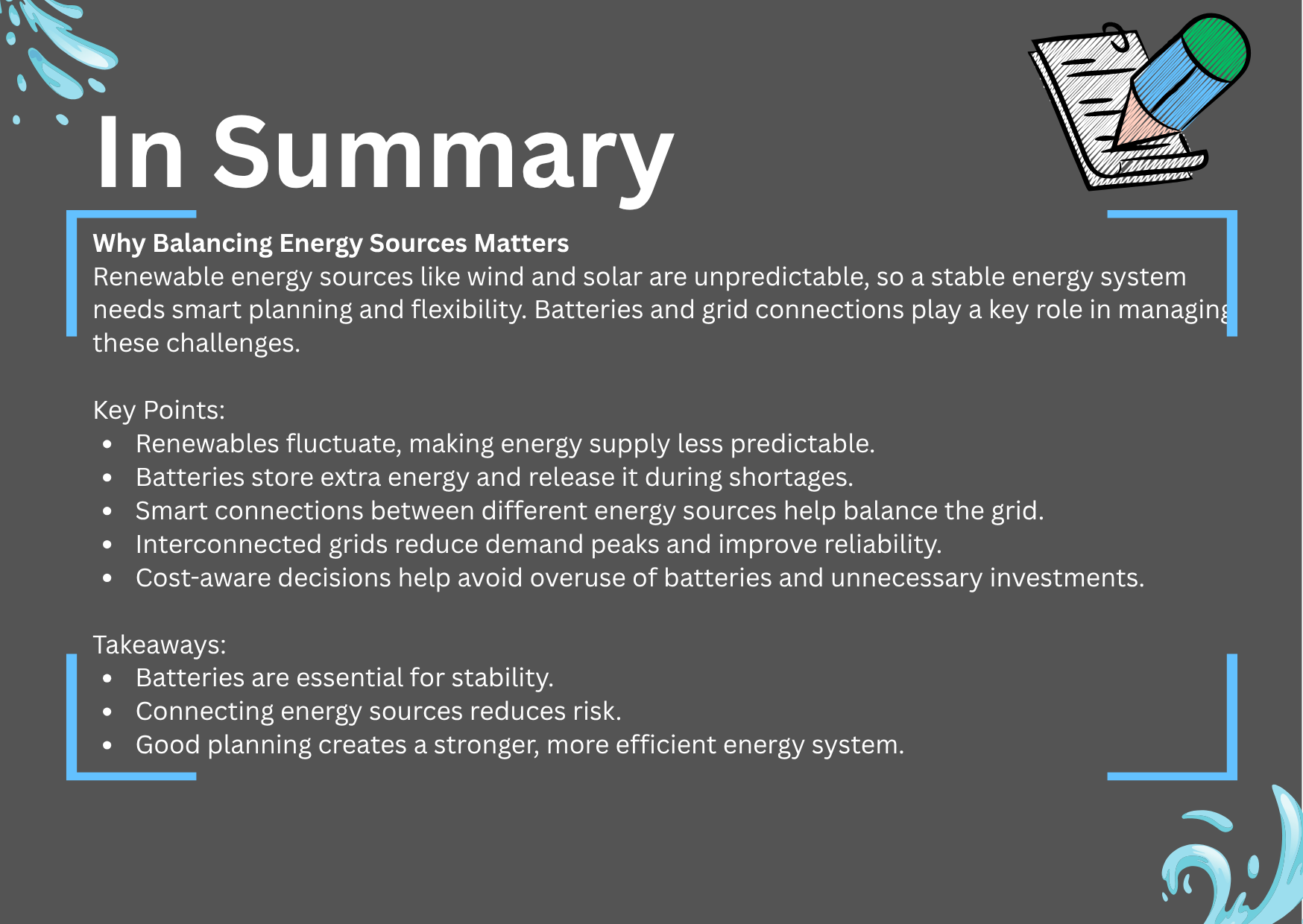👋 Welcome
Welcome to the Hydro Learning Adventure! Click "Next" to begin your journey.
💧 Welcome to the World of Hydro Energy!
Imagine using the force of flowing water to generate electricity. That’s exactly what hydropower does—using turbines to transform the energy of water into clean, renewable power.
In this workbook, you’ll dive into the fascinating world of hydropower: how it works, why it matters, and how it can help build a more sustainable future.
🌱 Why Learn About Hydro Energy?
With climate change and limited fossil fuels, hydropower plays a key role in creating clean, reliable energy. It reduces emissions, protects ecosystems, and offers powerful solutions for the future.
📘 What You’ll Learn
- Hydropower Basics: What hydro energy is and where it’s harnessed
- Water Wheels and Turbines: How they work and how to make them more efficient
- Water Behavior: How moving water carries energy
- Turbine Technology: How turbines generate electricity
- Comparing Renewables: Hydro vs. solar vs. wind
- Energy Demand and Supply: Balancing base load and peak load
🔍 How It Works
This workbook combines explanations, experiments, and activities to help you explore hydropower from both scientific and practical perspectives.
🌊 Get Ready to Flow
By the end of this workbook, you’ll understand how hydropower works and why it’s important for a cleaner, greener future.
You’ll gain tools and knowledge to explore real-world energy solutions—and help shape a brighter tomorrow.
🌊 Why is Hydropower Important?
Welcome to the world of Hydropower — energy from moving water! The word hydropower comes from the Greek word “Hydor” meaning water, and power, which refers to energy.
Hydropower is created by using the motion of water — often through rivers, dams, or waterfalls — to generate electricity. This movement is part of the natural water cycle, driven by the energy of the sun.
✅ Key Advantages of Hydropower
- Renewable Energy Source: Hydropower relies on the water cycle, which is continuously powered by the sun. Because water is naturally replenished by rainfall and rivers, hydropower is a sustainable source of energy that won’t run out.
- Environmentally Friendly: Once built, hydropower plants produce almost no greenhouse gas emissions, helping reduce climate change and air pollution.
- Reliable and Consistent Energy: Unlike solar or wind power, hydropower is available almost all the time—day or night, rain or sunshine—making it ideal for meeting steady energy needs and balancing the grid.
- Energy Storage Capabilities: Some hydropower plants can store energy by pumping water to higher ground during low demand and releasing it when demand increases. This makes them work like natural batteries!
- Energy Independence: Hydropower uses local water resources. That means Ghana can reduce its dependence on imported fuels, stabilize energy prices, and increase long-term energy security.
🇬🇭 Why is Hydropower Important in Ghana?
In 2020, Ghana’s energy mix was dominated by fossil fuels (69%), with renewables making up 31%. Hydropower, with major plants like the Akosombo and Bui Dams, has long been a key part of the country’s energy system. It not only contributes significantly to electricity generation but also supports irrigation in surrounding areas. Ghana has substantial untapped potential for expanding hydropower, which could further bolster its renewable energy capacity. The government continues to explore ways to harness more of the nation’s water resources for sustainable energy generation.
🚀 What’s Next?
In the next sections, you’ll learn how hydropower systems work, how water gets turned into electricity, and how you can even build your own models.
Let’s begin your journey into hydropower — and discover how water can light up the future!
📘 Key Hydropower Terms
Use this glossary to understand important terms you’ll encounter throughout your hydro learning journey.
🧪 Additional Materials for Experiments
- Plastic Box (at least A4 size): To imitate river basin.
- Sand: To serve as river floor.
- Beaker with 300ml of water: For flowing water.
- 2 rulers: To record observations.
- Bucket/Sink/Container: To catch runoff water.
- Cardboard: Cut to match the width of the pan’s interior, with a 2–3 cm opening in the center.
- Books: To support the pan and create an incline of at least 5 cm.
- Paper Glue: To glue the paper water wheel.
- Waterproofing spray for paper: Regular waterproofing spray to coat the paper water wheel.
- Fully printed template of the Paper Water Wheel
- Scissors: To cut the paper water wheel.
- Towel or paper towels: To catch up runoff water.
- Permanent marker: To mark the bottle.
- Duct tape: To let out water of bottle.
- Empty 2-liter soda bottle: Used as water bottle.
- Push pin: To create hole in bottle.
- 3 drinking straws: To form longer water path.
- Small objects: To create obstacles (e.g., cotton balls, sponge pieces, or crumpled paper)
- Multimeter
📦 Hydro Kit Overview
Inside the Hydro Kit Box you will find these materials:
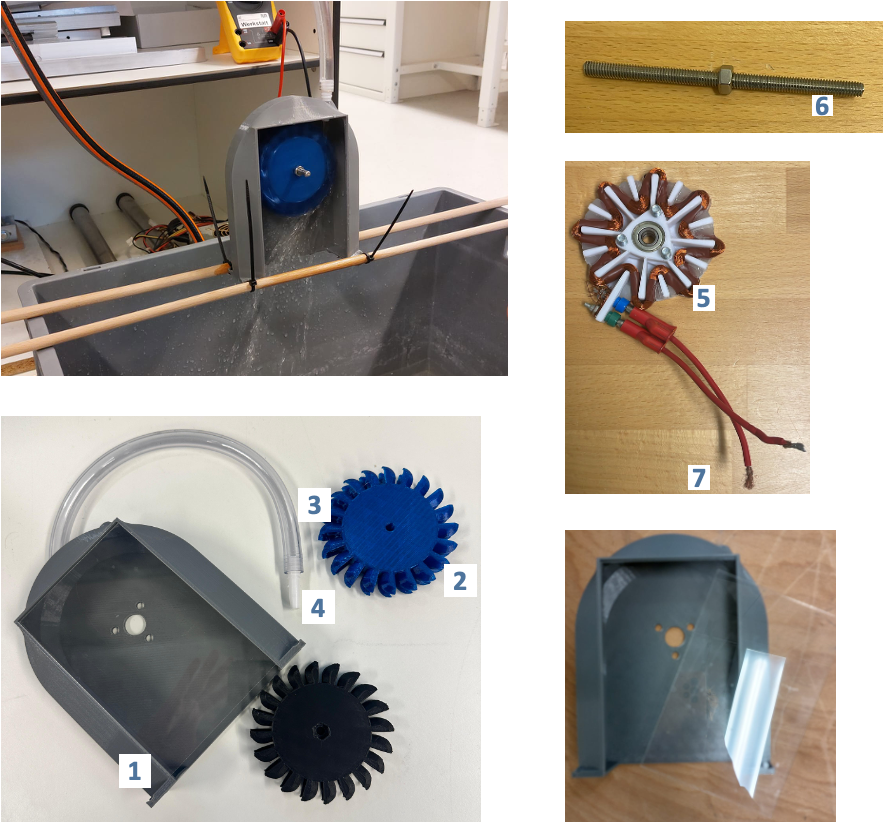
- Hydro turbine case
- Turbine
- Hose (different length of hose to the one on the picture)
- Nozzle to connect the hose to the case of the turbine
- Magnetic generator
- Long bolt
- Cables to connect to the multimeter
- Acrylic cover
🔧 How to Start Using the PV Panel Kit
Follow the steps below to assemble the PV Panel Kit:
Step 1: Attach the Turbine to the Case
- Gather the Parts: Locate the turbine, the turbine case, and the acrylic cover.
- Position the Turbine: Place the turbine inside the turbine case, ensuring it fits securely and is aligned properly for smooth rotation.
- Secure the Turbine: Attach the turbine to the case using the provided mounting mechanism inside the case. Ensure the turbine can spin freely without obstruction.
Step 2: Connect the Generator
- Attach the Generator: Place the generator at the back of the turbine case, aligning it with the turbine’s shaft.
- Secure the Connection: Insert the long bolt through the case, connecting the turbine to the generator.
- Adjust the Pressure: Tighten or loosen the bolt to adjust the pressure between the turbine, the case, and the generator. Ensure the connection is firm but allows the turbine to spin smoothly.
Step 3: Install the Acrylic Cover
- Place the Acrylic Cover: Position the acrylic cover in front of the turbine case to enclose the turbine securely.
- Adjust the Bolt Tip: Extend or retract the tip of the bolt as needed to ensure the acrylic cover fits snugly over the turbine case. This ensures the setup is water-tight and ready for use.
Step 4: Attach the Hose
- Connect the Hose: Attach the hose to the top of the turbine case using the nozzle provided in the kit.
- Ensure a Tight Fit: Check that the hose is securely attached to prevent leaks during water flow.
Step 5: Secure the Case to a Surface
- Locate the Mounting Holes: Use the pre-drilled holes at the bottom of the turbine case.
- Fix the Case: Secure the turbine case, generator, and hose to a stable surface using screws or clamps (not included in the kit). This ensures the assembly remains steady during the experiment.
Important Notes for Experimentation:
- Ensure all parts are securely tightened before conducting any experiments.
- The acrylic cover must be properly aligned to avoid water leakage.
- Place the assembled kit on a flat, stable surface to ensure safety and efficiency during use.
By following these steps, you can successfully assemble the hydro energy kit and prepare it for experiments to observe the principles of hydro energy in action.
🧰 Multimeter
📏 What is a Multimeter?
A multimeter is a handy tool that can measure electrical quantities like voltage, current, and resistance. Here’s a simple guide on how to use it, along with an explanation of its key parts and steps.
🔩 Parts of a Multimeter
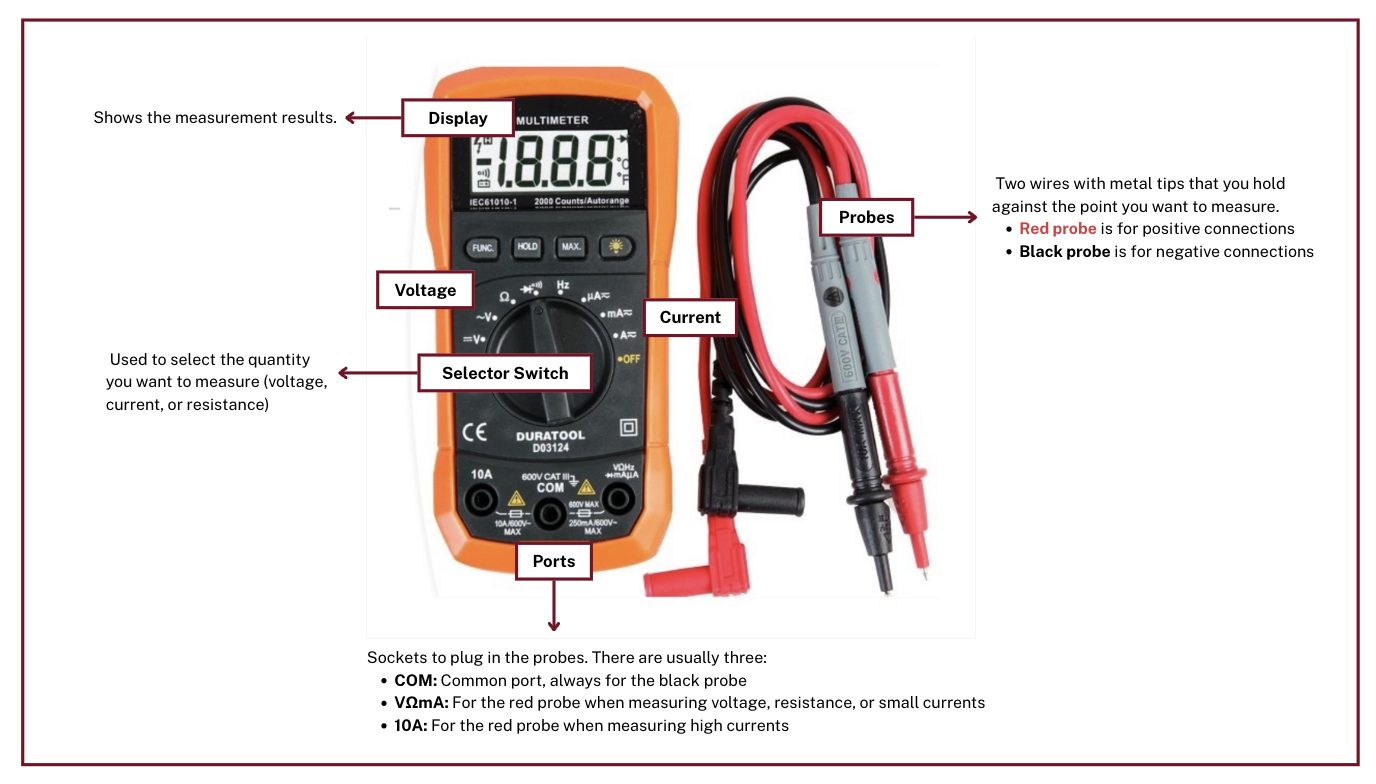
🛠️ Steps to Use a Multimeter
- Turn on the Multimeter: Make sure the multimeter is on by turning the dial.
- Select the Measurement Type:
- Voltage (V): For DC voltage, turn the dial to “V” with a straight line; for AC voltage, to a wavy line.
- Current (A): Turn the dial to “A”. Choose between “mA” or “A” depending on expected current (we usually use mA).
- Resistance (Ω): Turn the dial to the “Ω” symbol.
- Set the Range: Start with the highest expected range to avoid damage.
- Connect the Probes:
- Black probe → COM port
- Red probe → “VΩmA” for most measurements; “10A” for high current
- Take the Measurement:
- Voltage: Touch probes to two points; observe polarity.
- Current: Insert the multimeter into the circuit to allow current to pass through it.
- Resistance: Touch both ends of the component/connection.
- Read the Result: Look at the display and note the unit (V, A, mA, Ω).
- Turn Off the Multimeter: Rotate the dial to OFF.
⚠️ Safety First!
- Never measure voltage when the multimeter is set to current or resistance!
- Start with the highest range when unsure.
- Be cautious with high voltage/current circuits.
- Avoid touching metal probe tips directly — for safety and accurate readings.
“Hands off!” — Safety first, always!
Now you can safely and effectively use a multimeter — enjoy measuring and discovering the world of electricity! ⚡
💧 Chapter 1 – Hydro Basics
🌊 Basics – Wonders of Moving Water
🎯 Learning Objective
By the end of this chapter, you will be able to:
- Understand the Essentials of Hydropower: Gain a solid grasp of the geographical locations and natural conditions that make hydropower possible.
- Discover the Power of Rivers: Learn how rivers, with their dynamic flows and diverse conditions, play a critical role in generating hydropower.
- Dive into Ocean Energy: Explore the fascinating motion of tides and waves and see how innovative systems harness their immense energy potential.
- Harness the Energy of Mountains: Investigate how falling water in mountainous regions transforms potential energy into kinetic energy, driving turbines like water wheels to produce electricity.
- Marvel at Dams and Reservoirs: Delve into the construction of colossal dams and reservoirs, understanding how they control water flow and fuel large-scale energy production.
- Environmental Impacts of Moving Water: Gain fundamental insights into how moving water shapes the land and interacts with ecosystems around it.
By the end of this chapter, you’ll be empowered with foundational knowledge about water energy systems, ready to make informed decisions about optimizing their performance and understanding their role in a sustainable energy future!
🌊 🗺️ 1.1 Where is Hydro Energy Found?
💡 Hydro Power Hunt Challenge
In this Challenge, you and your team will explore and identify potential locations where you would expect hydro energy to be located, focusing on specific regions.
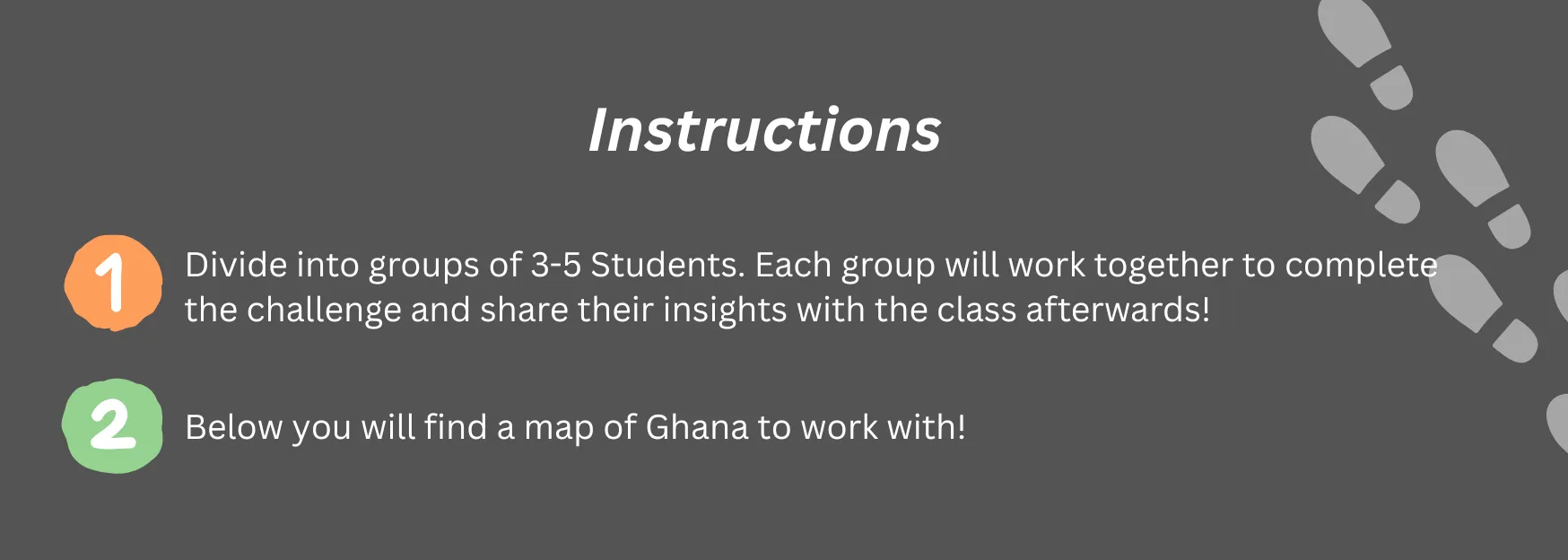
✍️ Exercise: Task 1
- Locate Hydropower Sites: Using the map, identify and mark potential locations where you think hydroelectric power plants could be built. Indicate these spots with red dots on your map.
- Discuss the Suitability: For each location, consider the geographical features (elevation, proximity to water sources etc.) that make it a good choice for hydropower. Write down your reasons in short bullet points.
- Rank the Locations: Arrange your chosen locations from most suitable to least suitable. (For example, indicate it with a 1, 2 … next to the red dots). Be prepared to provide some arguments for your top 3 locations.
- Present your Findings and discuss in class!
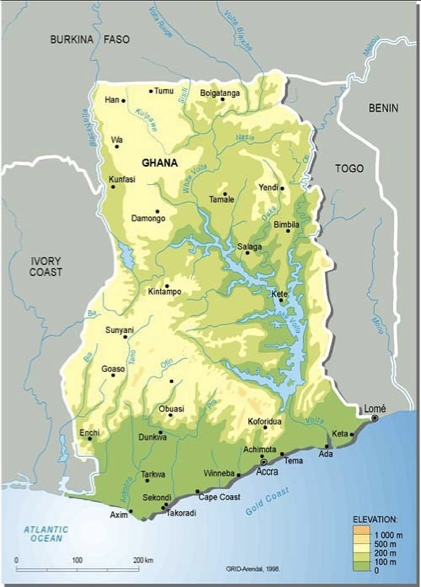
✍️ Exercise: Task 2
🔄 Hydro Energy and Energy Conversion
- In __________ regions water can flow very fast, creating more energy.
- Water stored behind a dam has __________ energy because of its height.
- When water flows downhill due to __________, it gains __________ energy.
- The moving water spins __________, which are connected to a __________ to create electricity.
- The word “hydro” comes from the Greek word for __________.
- Hydro energy is a __________ energy source. It uses the movement of water to perform __________.
- __________ also inhabit hydro energy, which can be harnessed with innovative concepts.
- __________ are large structures built to block and control the flow of water, aiding in hydroelectric energy production.
💧 The Water Cycle
Fill in the blanks with the correct words from the word bank:
The __________ moves water around the Earth and atmosphere in different stages. First, water turns into vapor through __________ when the heat from the __________ warms it. Next, the vapor cools and turns into tiny droplets in the process called __________. These droplets come together to form clouds. Then, water falls back to the Earth as rain, snow, or hail, a process known as __________. Finally, the water collects in rivers, lakes, and oceans, completing the cycle.
📦 Word Bank:
potential, gravity, turbines, evaporation, water, precipitation, generator, mountainous, dams, condensation, water cycle, renewable, work, oceans, kinetic, sun
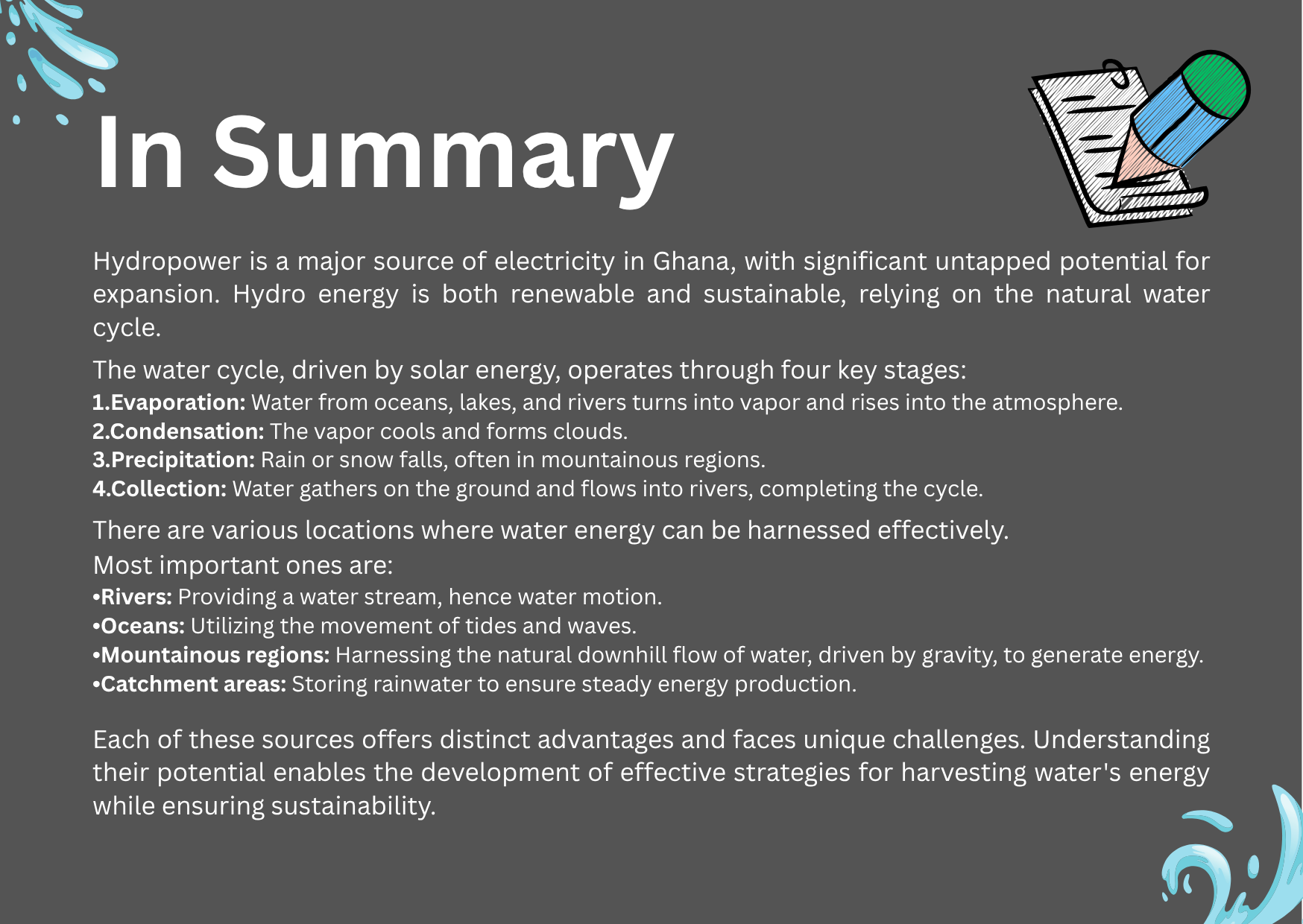
🌊 1.2 Rivers
The target of this exercise is to understand why rivers are a vital resource for hydro-energy. You will explore how to manage river streams effectively to harness their energy potential.
📝 Exercise
Task 1
- Team up with your seat neighbor and think about a river nearby.
- Did you experience differences in the flow of its water stream during the year?
- When and why did the water stream appear differently?
- Are there parts of the river that have quicker water streams? If so, what could cause these differences?
- You may answer in bullet points or create a sketch with descriptions.
Task 2 – Operating a Semi-Regulated River for Energy Production
Objective: Analyze a semi-regulated river for hydroelectric energy production under different scenarios. Predict outcomes, discuss challenges, and propose solutions to maintain energy production while managing other factors.
Start Scenario:
- A semi-regulated river flows through a hydroelectric power plant.
- Normal production capacity: 30 MW under average water flow conditions.
Your Role: Work individually or in small groups to analyze each scenario and answer the open-ended questions.
Scenario 1: Normal Flow
Description: The river flow is steady and the power plant operates normally, producing a constant rate of 30 MW of electricity.
- What factors might affect the stability of this flow over time?
- Why is it important to maintain a balance between energy production and water levels?
Task 3 – Scenario 2: Drought
Description: A prolonged drought reduces the river’s water flow significantly. Rainfall is minimal, and reservoir levels are dropping.
- What happens to electricity production when water flow is reduced?
- What actions could the power plant operators take to sustain energy production during the drought?
- What are potential consequences of overusing the remaining water in the reservoir?
Task 4 – Scenario 3: Heavy Rainfall
Description: Monsoon-like rains cause a sudden surge in the river’s water level. The reservoir is at risk of overflowing, and downstream areas may face flooding.
- Can electricity still be produced effectively when water levels are too high? Why or why not?
- What strategies could the power plant use to manage the excess water?
- How could this scenario impact communities and ecosystems downstream?
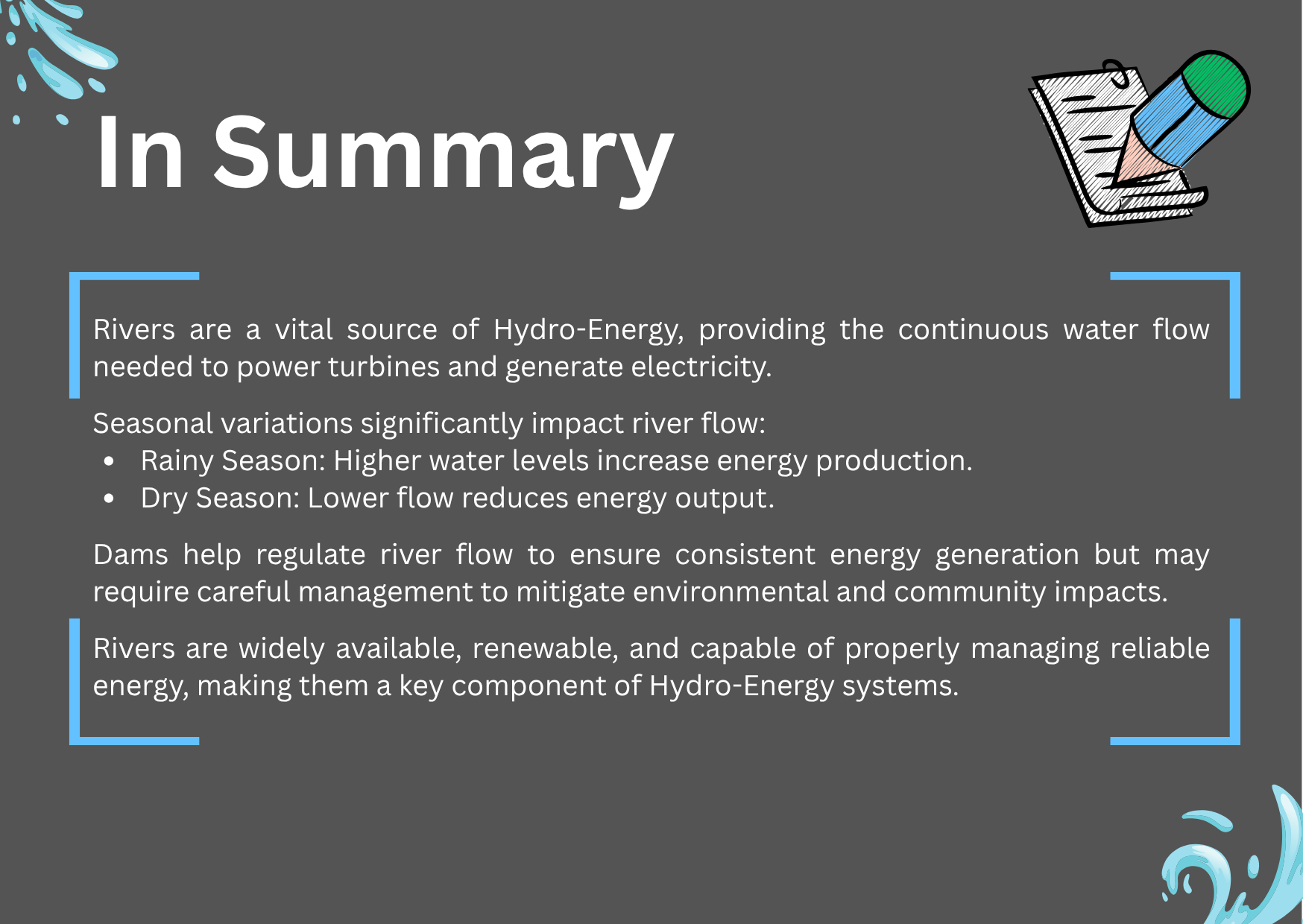
🌊 1.3 Oceans
The target of this exercise is to explore how the motion of ocean water can be harnessed to produce renewable energy. You will investigate technologies like tidal and wave energy systems that transform this natural motion into sustainable power sources.
📝 Exercise
Task 1 – Understanding Tides and Wave Energy
- Think about the ocean, like the Atlantic Ocean, Ghana.
- What natural forces create tides and waves in the ocean?
- What do you think is the largest tidal difference (highest and lowest water levels) found on earth?
- How might we use these natural forces, like tides and waves, to generate hydropower?
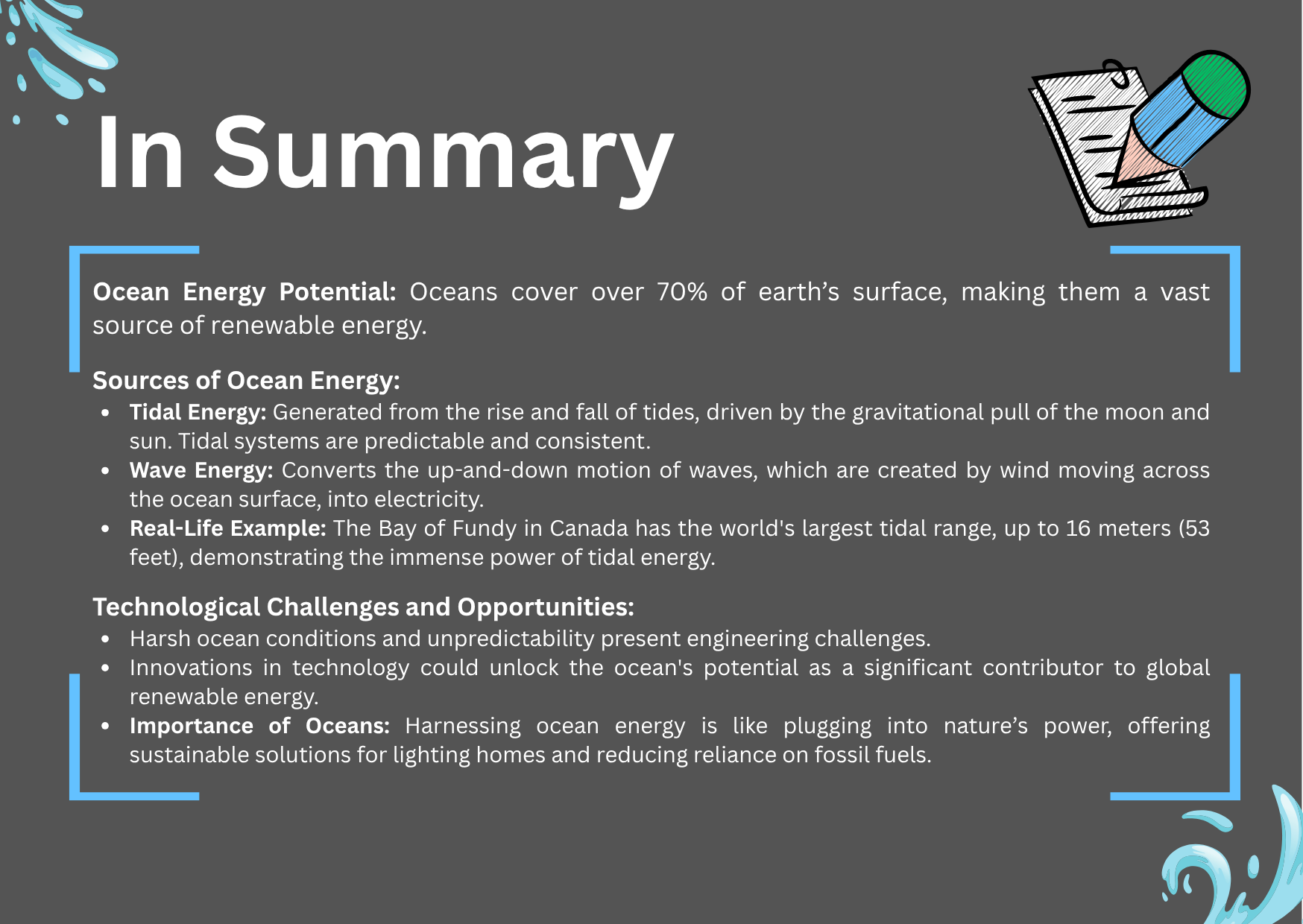
⛰️ 1.4 Mountain Regions
The target of this exercise is to understand how hydro energy can be effectively harnessed in mountainous regions. You will learn about the unique challenges and opportunities presented by steep terrains and fast-flowing streams in these areas.
📝 Exercise
Task 1 – Understanding Hydro Energy in Mountainous Regions
Debating Game
Team GREEN – Location 1: High up the mountain, meaning a steep incline.
Team BLUE – Location 2: At the bottom of the mountain, meaning the incline is less steep.
- Objective: Each team argues why their location is best for building a water wheel to generate energy.
- Focus: Compare water motion (speed and force) and availability (volume and consistency). Which location is more environmentally sustainable considering the potential impacts on ecosystems and water resources?
- Explain: How do these differences affect water wheel performance?
You can use this debating structure:
- Opening Statements: 2–4 minutes per team.
- Counterarguments: 2–4 minutes per team.
- Rebuttals: 1–3 minutes per team.
- Closing Statements: 1–2 minutes per team.
Now! Split into two equal groups: Team GREEN (top of the mountain) and Team BLUE (bottom of the mountain).
💡 Definition – Waterfall Effect
- The waterfall effect refers to the energy generated by water falling from a height.
- This converts gravitational potential energy into kinetic, then into mechanical or electrical energy.
- Water at the top = Stored Potential Energy (like a stretched rubber band analogy).
- Falling water = Energy in motion.
- Bottom = Spins a wheel or turbine using the motion.
- This works both in small systems (like a water wheel) and large dams alike.
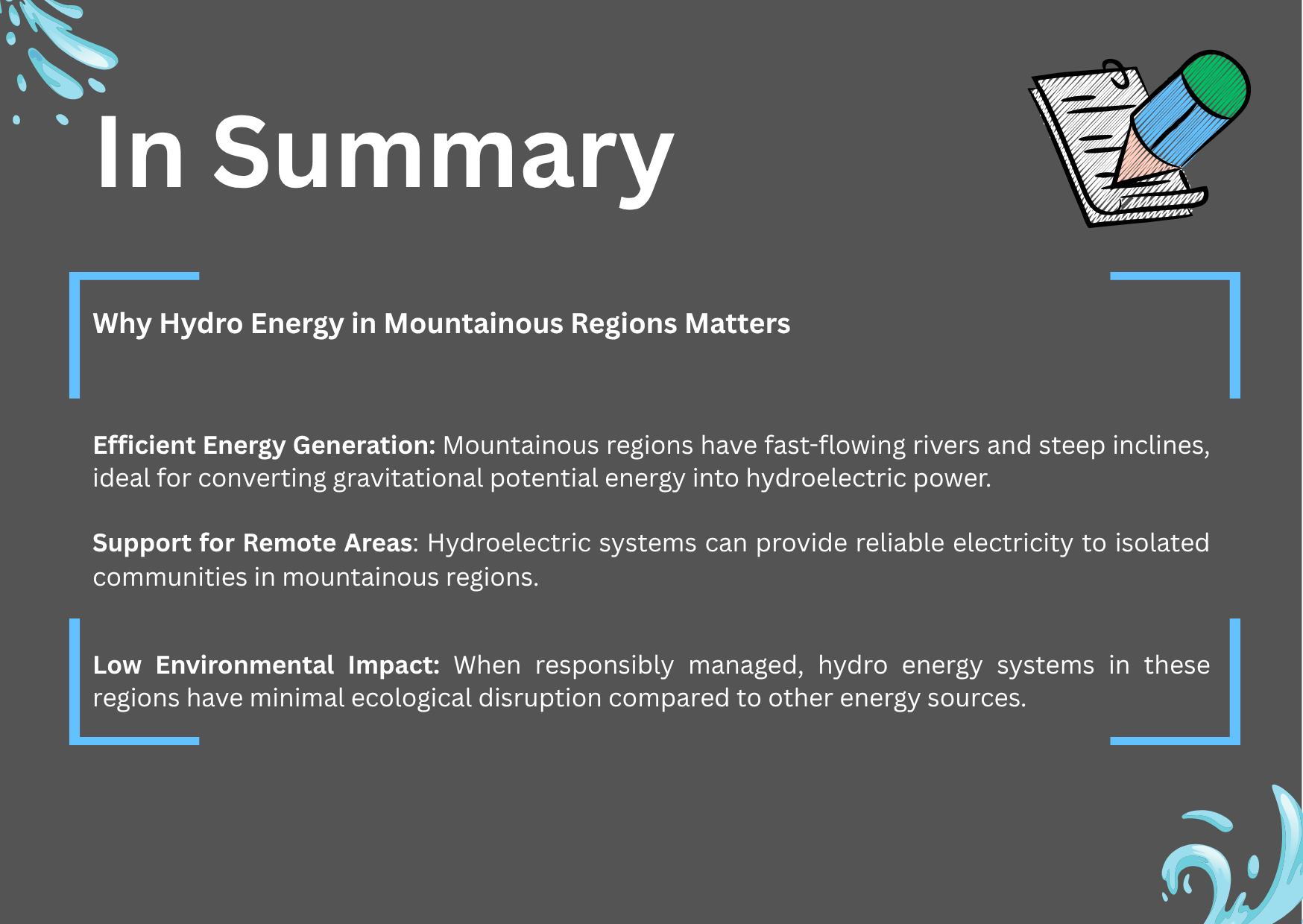
🌍 1.5 Catchment Area, River Basin and Environmental Impacts
The target of this exercise is to learn what a catchment area and river basin are and how they are connected to dams and reservoirs. Additionally, you will explore how these systems impact their surrounding environment.
📝 Exercise
Task 1
- What happens when rain falls on a hill or mountain? Where does the water go?
- How do you think water gathers into streams and rivers?
- Draw what you imagine a “catchment area” or “river basin” might look like.
Task 2 – Understanding Dams and Reservoirs
- Where would you place a dam to collect and store water?
- How would the dam affect the flow of the river and the landscape around it (Up-/Downstream of the dam)?
- Sketch a dam and reservoir using your knowledge of catchment areas and river basins.
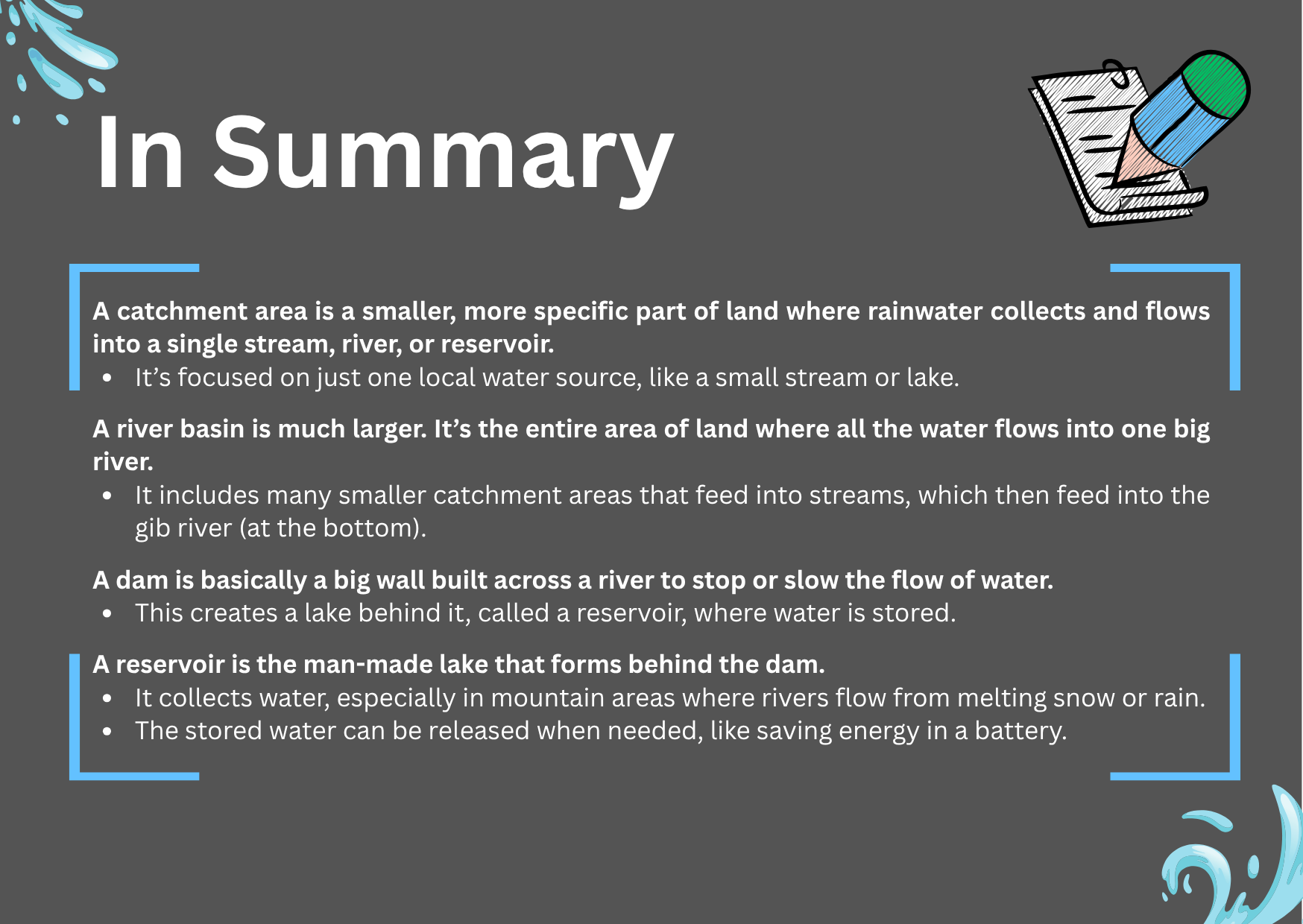
🧪 1.6 Environmental Impacts Game
In this Challenge, you and your team will explore and identify the effects of silting, flooding, and water obstructions on land. Through a hands-on experiment, you will observe how these factors can alter the landscape, impact soil stability, and shape the environment over time.
Materials Needed:
- Plastic Box (at least A4 size)
- Sand
- Beaker with 300 ml of water
- 2 rulers
- Bucket / Sink
- Cardboard (cut to match pan width, with 2–3 cm opening in center)
- Books (to raise one side by at least 5 cm)
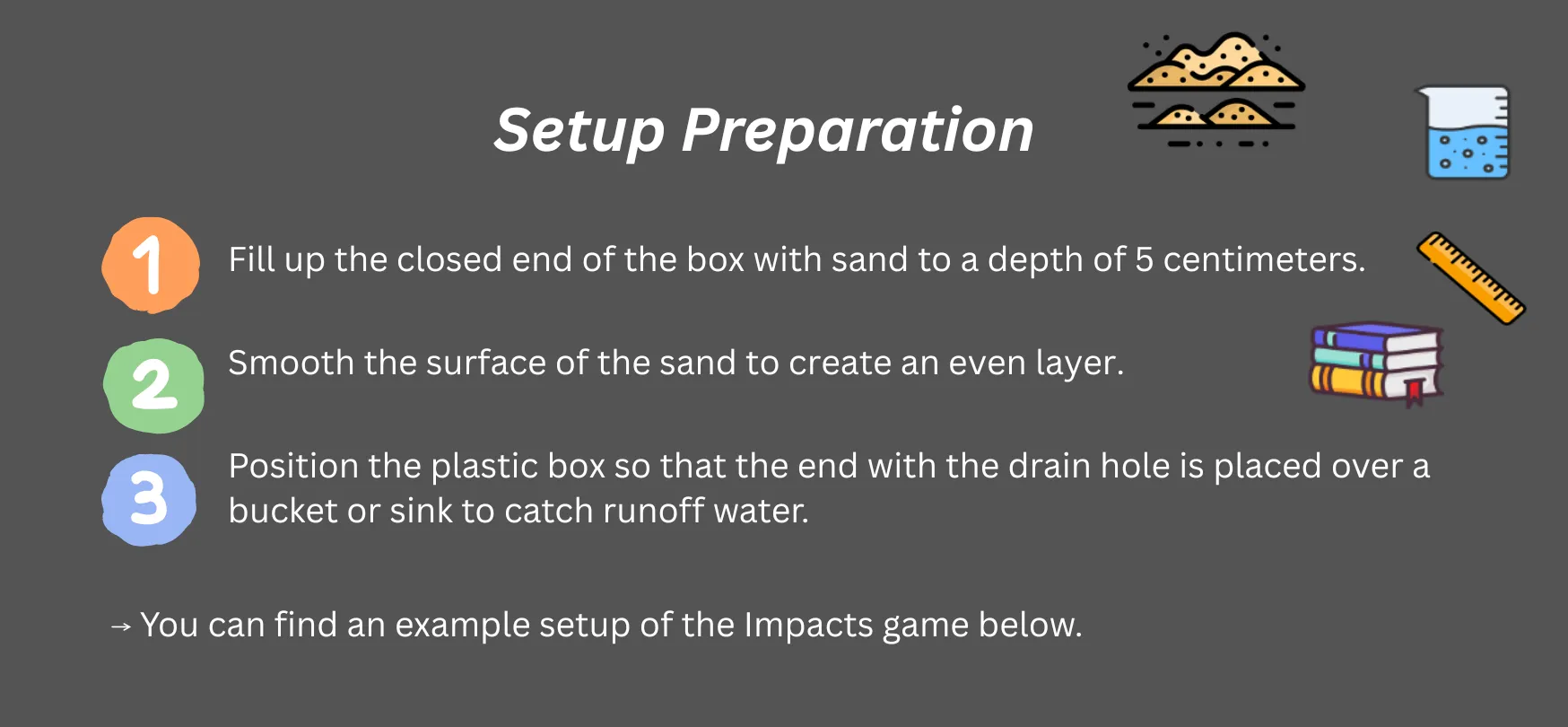
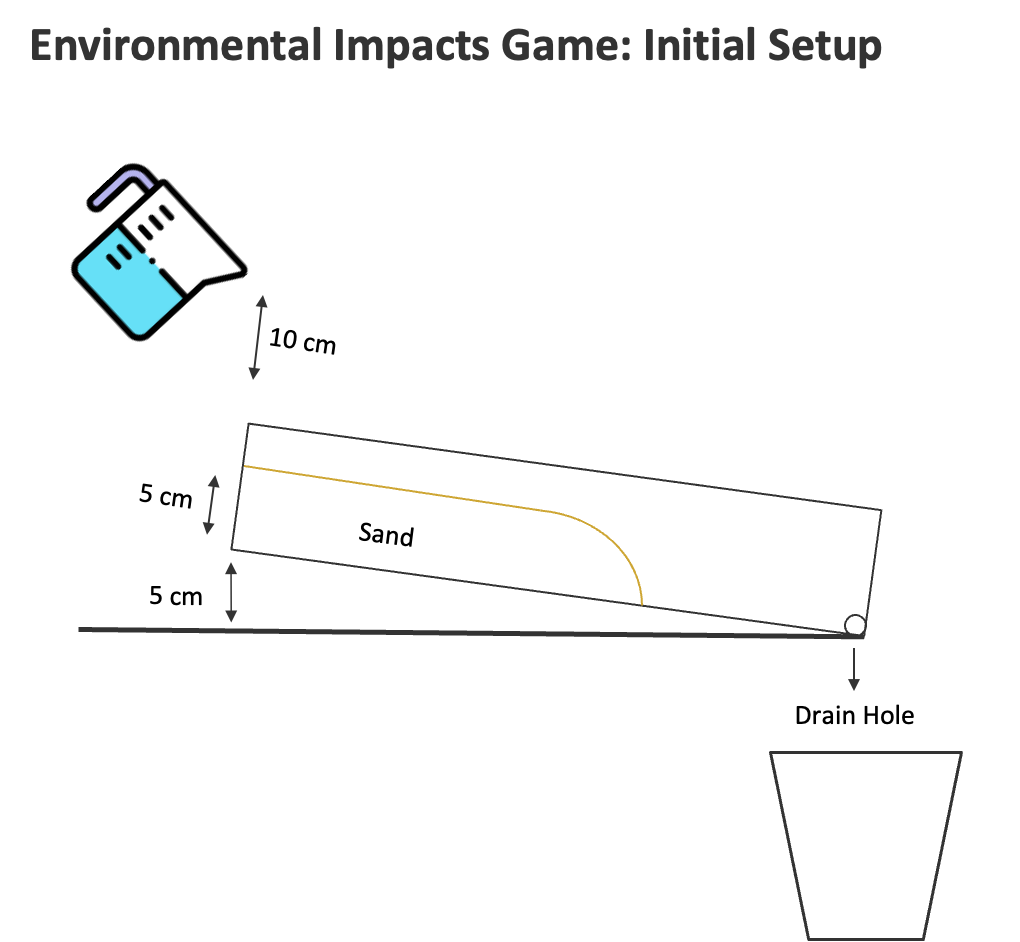
🔬 Exercise:
Task 1 – How does water change land?
- Place books underneath the box, such that it raises the end of it for at least 5 cm. (make sure it’s not wobbling!)
- Hold the beaker 10 cm above the sand and pour it onto the end in a slow, steady stream.
- Record your observations.
Draw top-view pictures of the sand before and after pouring water on it.
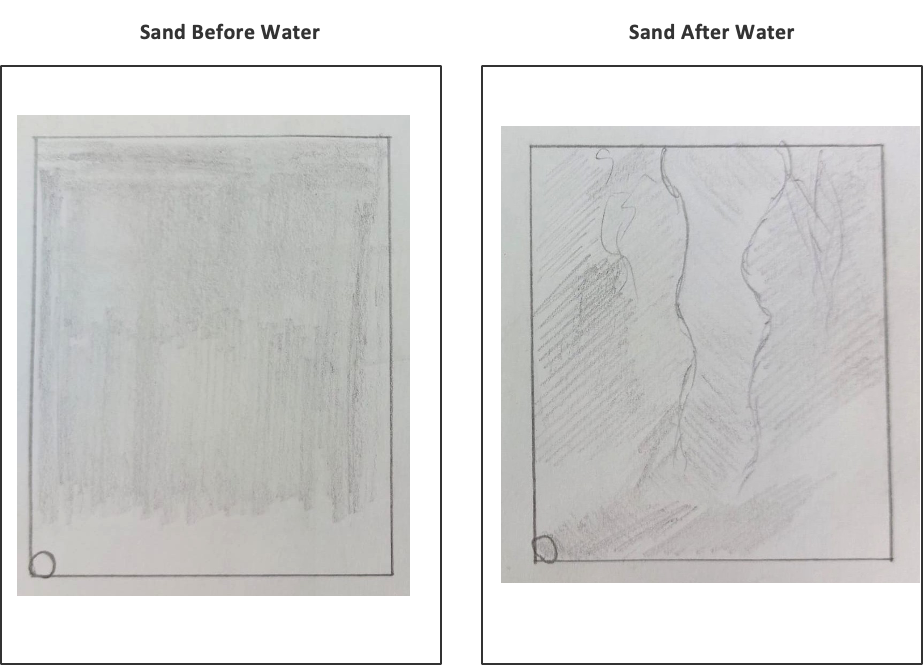
Explain how the water’s movement affected the sand in your experiment. What changes did you notice, and what might these represent in a real-world environment?
Task 2 – Water Obstruction
- Prepare the box as described in the setup.
- Insert one ruler into the sand near the middle on the right side and another ruler on the left side of the pan.
- Elevate the end of the box containing the sand to create an incline.
- Hold the beaker 10 cm above the sand. Slowly and steadily pour the water onto the raised end of the pan.
- Record your observations.
Draw top-view pictures of the sand before and after pouring water on it.
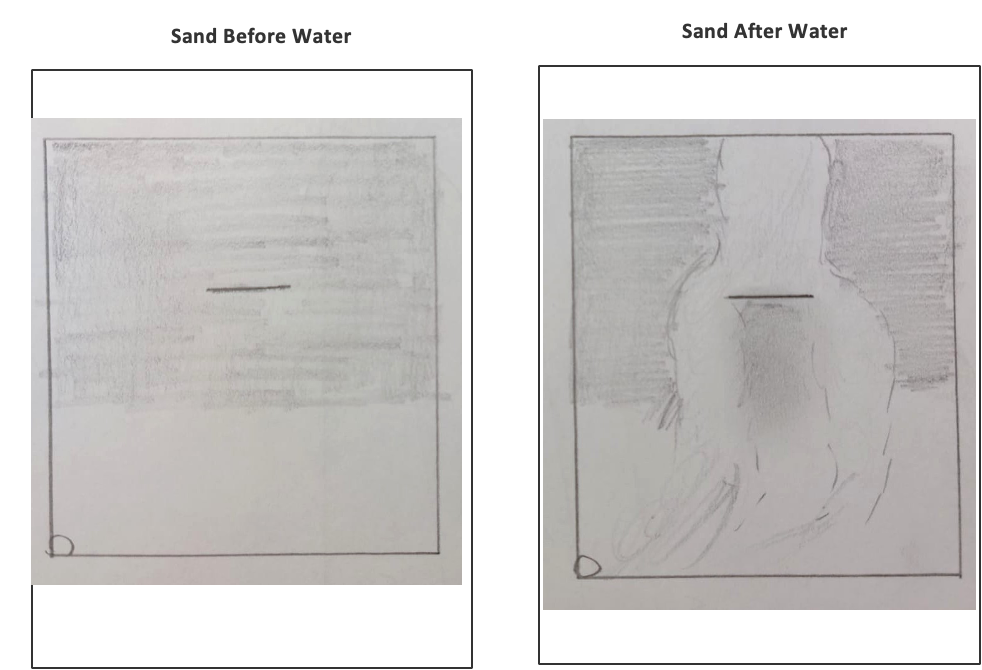
Explain how the water’s movement affected the sand in your experiment. What changes did you notice, and what might these represent in a real-world environment?
Task 3 – Water Silting & Riverbank Erosion
- Prepare the box as described in the setup.
- Shape a river: Use your finger or tool to form a winding river (meandering path) in the middle of the box, leading to the end of it.
- Elevate the end of the box containing the sand to create an incline.
- Hold the beaker 10 cm above the sand. Slowly and steadily pour the water onto the raised end of the box until it’s half empty (simulate river flow).
- When the water is flowing in your river, increase the amount by pouring the rest of the water from the beaker faster.
- Record your observations.
Draw top-view pictures of the sand before and after pouring water on it.
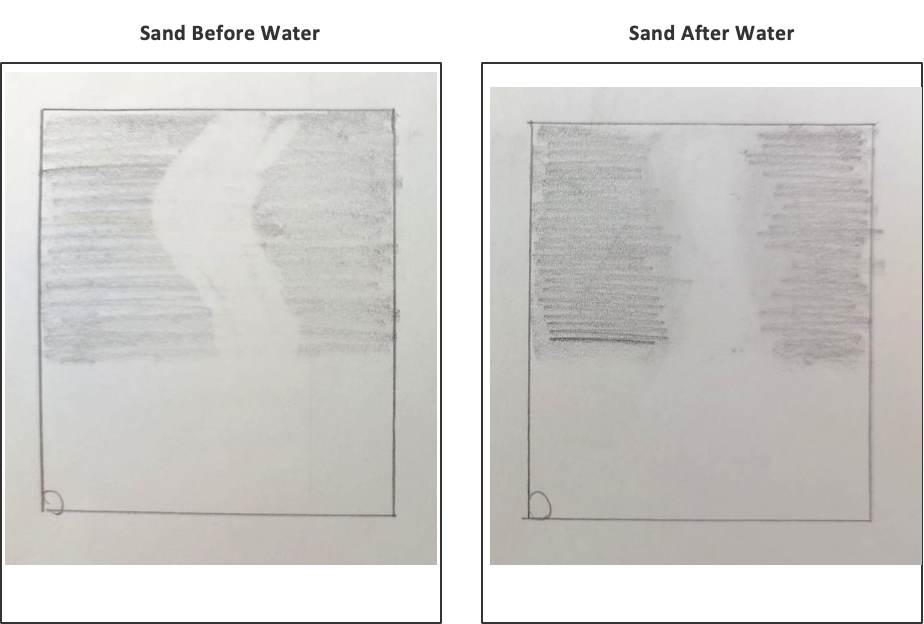
Explain how the water’s movement affected the sand in your experiment. What changes did you notice, and what might these represent in a real-world environment?
Task 4 – Water Flooding
- Prepare the box as described in the setup.
- Insert the cardboard into the box to act as a barrier.
- Use a ruler or another piece of cardboard to cover the opening in the barrier, ensuring no water can flow through when you start pouring.
- Place books underneath the end of the box with the sand to raise it. Ensure the box is stable and does not wobble.
- Hold the beaker 5 cm above the sand. Pour all the water from the beaker onto the raised end of the pan (slow and steady) to simulate a reservoir filling up behind the barrier.
- Simulate the Flood: Once the beaker is empty, remove the ruler or cardboard covering the opening to release the water.
Draw top-view pictures of the sand before and after pouring water on it.
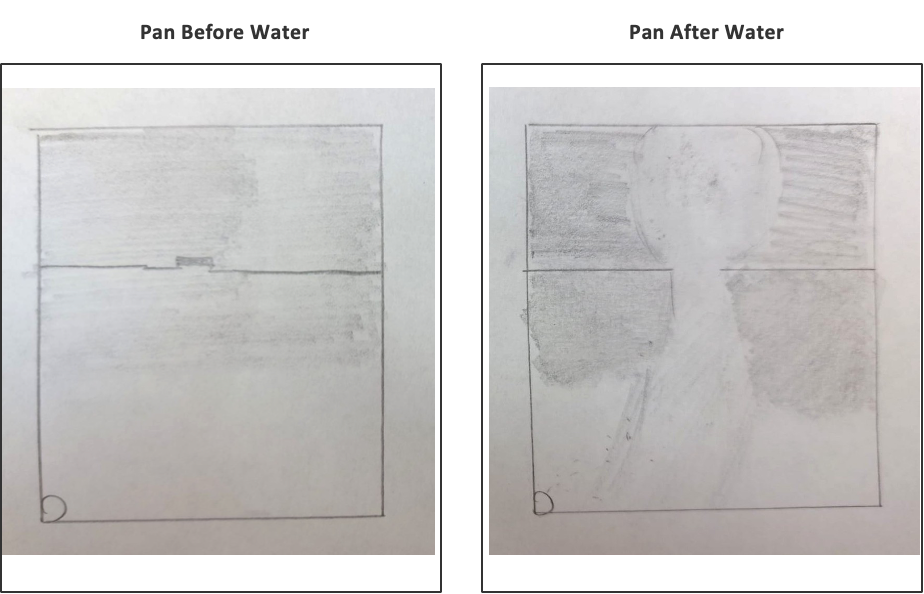
Explain how the water’s movement affected the sand in your experiment. What changes did you notice, and what might these represent in a real-world environment?
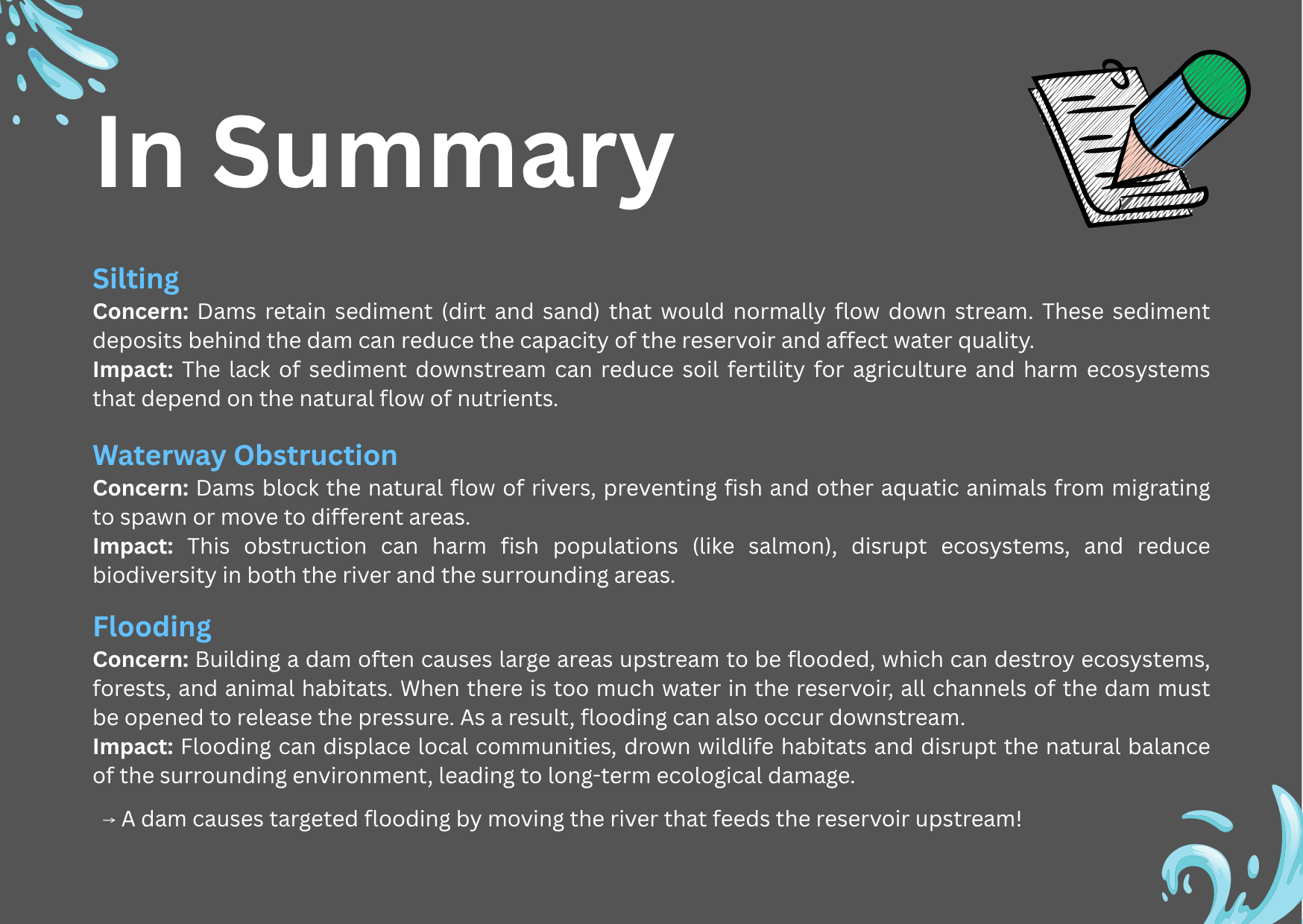

⚙️ Chapter 2 – Water Wheel and Turbine Types
💡 Learn by Building and Experimenting
🎯 Learning Objective
- In this chapter, you will embark on an exciting journey into the world of hydropower.
- Together with your team, you will construct your very own water wheel and explore the mechanics behind its operation. This hands-on task will help you understand how to efficiently run a hydroelectric power plant and uncover the critical role that buckets play in its functionality.
- You will also investigate the ideal types of water motion for a water wheel and discover how this connects to the formula for energy in hydropower systems.
- Additionally, through a hands-on experiment, you will see state-of-the-art turbines and learn about three distinct turbine designs.
- You will explore how these turbines differ, the principles behind their operation, and the reasons for their unique designs.
By the end of this chapter, you will not only have built a deeper understanding of hydropower but also gained practical insights into the technology driving modern hydroelectric systems.
🛠️ 2.1 Craft Your Own Water Wheel!
🔬 Experiment
Materials you need for this experiment:
- Fully printed template of the Paper Water Wheel
- Scissors
- Paper Glue
- Waterproofing spray for paper (regular waterproofing spray)
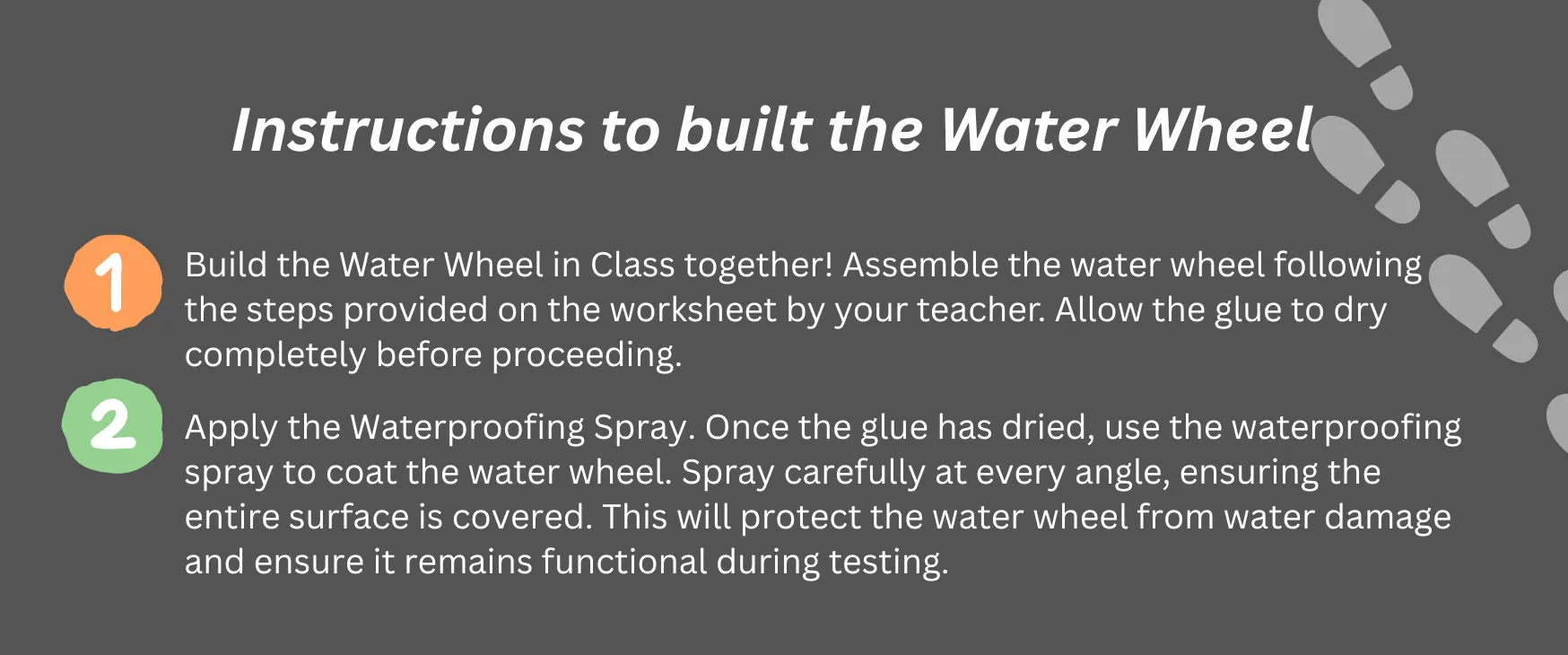
📝 Exercise
Task 1
Carefully examine the water wheel you have built. Observe its structure closely and reflect on how it operates.
Which parts do you think are the most important for its operation? Explain your reasoning.
Task 2
Take a closer look at the buckets on your water wheel. Imagine how they work when water flows into them.
- Why are the buckets the most important part for making the water wheel work well?
- How can the buckets be made such that they work more efficiently/provide more power?
- What else is a crucial parameter to get more power from a water wheel?
💡 Key Parts of the Water Wheel are:
- Blades or Buckets: Capture the flowing water, causing the wheel to spin.
- Wheel (Rotor): Holds the buckets and transfers motion.
- Axle: The central rod around which the wheel rotates.
- Supports/Frame: Keeps the wheel stable and secure.
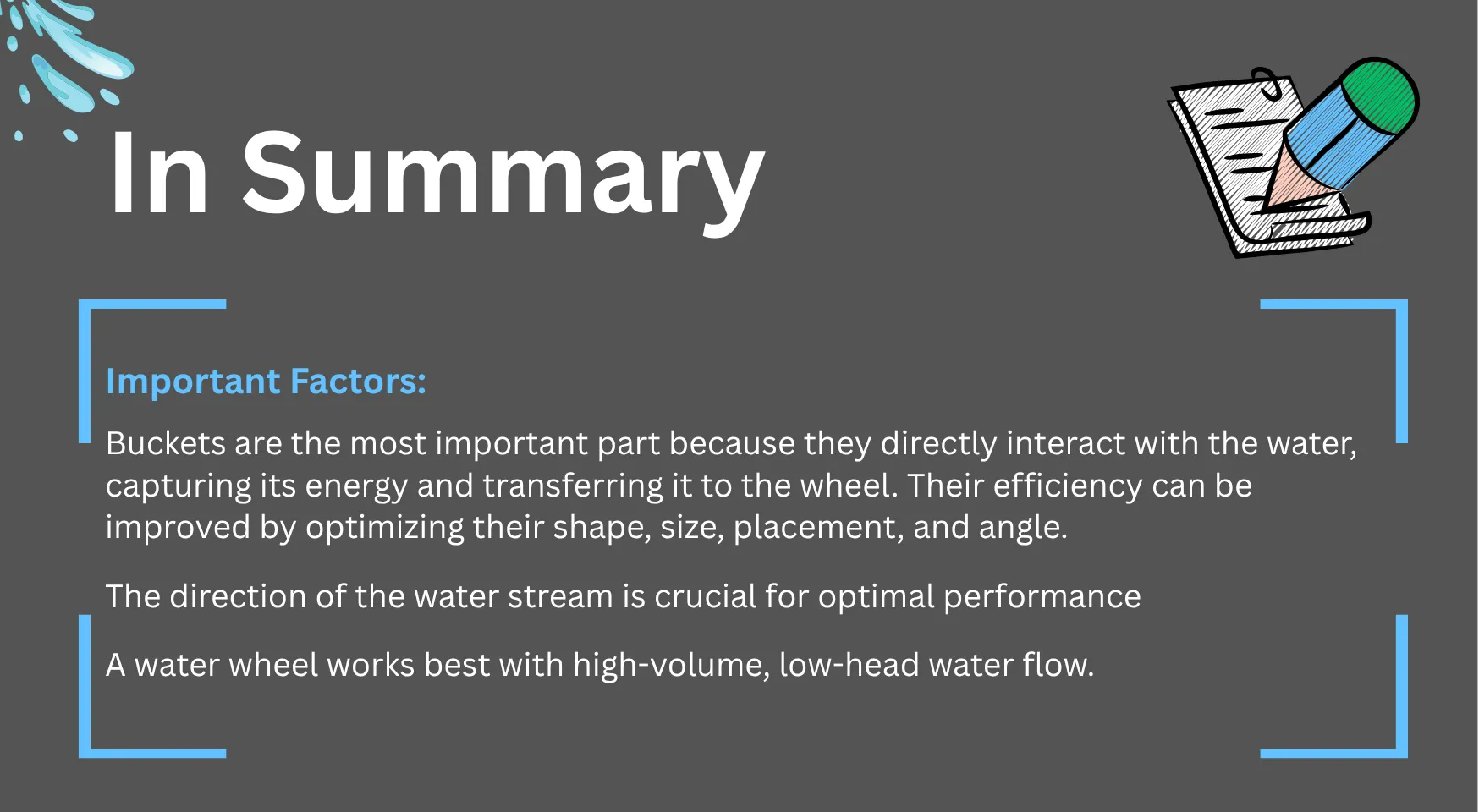
In Words: Energy = Density (p) × Volume (V) × Gravity (g) × Height (h)
- m for mass: relates to the amount of water.
- h for height: the higher the water is, the more potential energy it contains.
- g for gravity: pulls the water down, converting potential to kinetic energy (~9.8 m/s²).
- p for density: of water.
Potential Energy = m × g × h
Since m = p × V, insert into the formula:
Energy = p × V × g × h
In other words:
Total energy = potential energy + kinetic energy
Etotal = Epot + Ekin
⚙️ 2.2 Different Turbine Types in Hydro Energy
In this chapter, you will embark on an exciting experiment involving a 3D-printed hydropower plant equipped with Francis, Pelton, and Kaplan turbines. The goal of this experiment is to help you understand the three major types of water turbines, their unique designs, and the specific conditions in which they operate most efficiently.
You will gain insight into why different turbine types are necessary to harness the energy of water effectively in various environmental and flow conditions.
📝 Exercise
Task 1 – Name the turbines you see on the pictures
Picture 1:
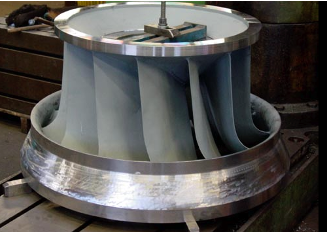
Picture 2:
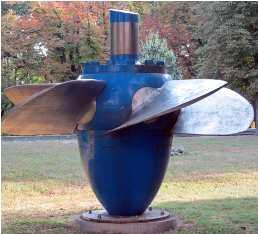
Picture 3:
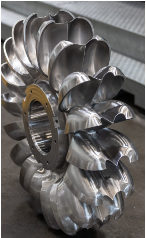
🎥 Videos and animations about the principles of operating different types of hydro turbines:


Task 2 – Guess the Why
Why do you think the types of turbines shown exist? Think about how each might work differently depending on the flow and pressure of water.
Task 3 – Match Turbine to Scenario
Which Turbine Type would you recommend for the following operation range scenarios?
- Very high head height and low flow rate of the water
- Low head height and high flow rate
- Medium head height and very high flow rate
For each scenario, add a real-world location where those conditions could exist (e.g., River, Dam, Mountain Stream, etc.).
Task 4 – Turbine Types and Their Operation Ranges
Below you can find a Turbine Operation Ranges Plot.
- Indicate where Pelton, Francis, and Kaplan Turbines’ operation ranges are.
- X-axis: Flow Rate in m³/s (flow of water per second)
- Y-axis: Head height in meters
- HINT: First make a dot to indicate the general location, then draw or imagine an area that represents the typical operating zone.
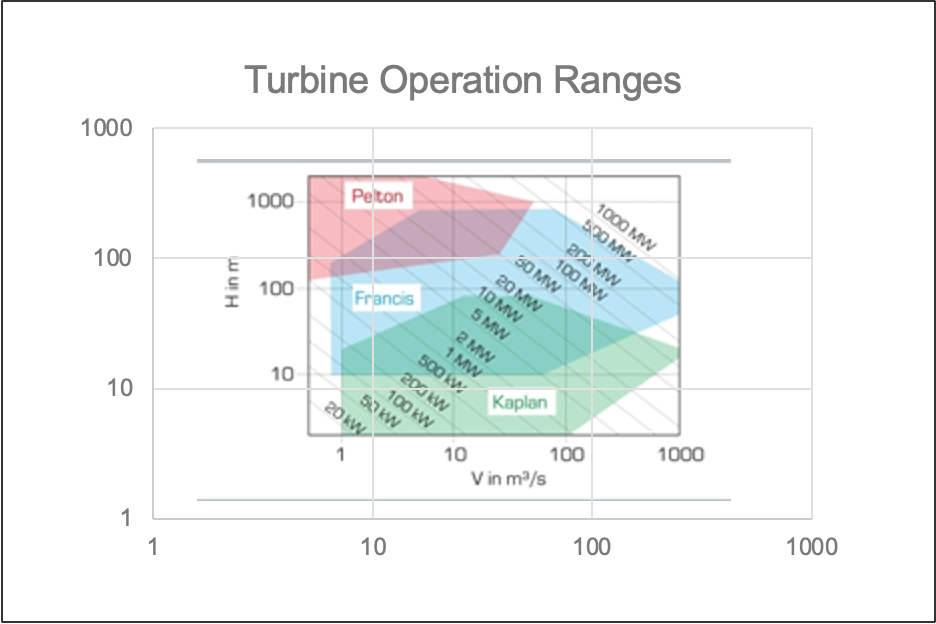
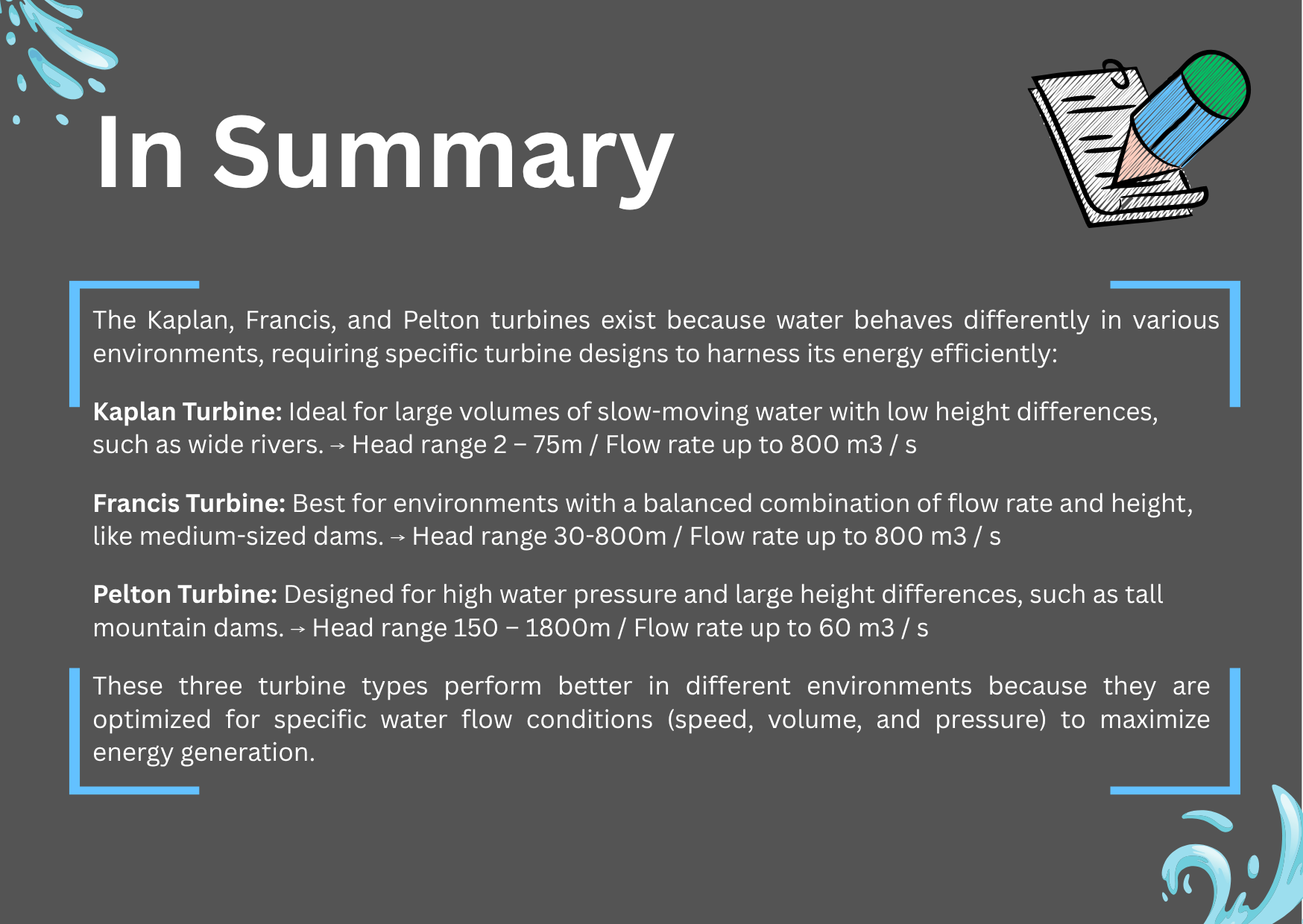
💧 Chapter 3 – Factors Affecting Turbine Performance – Pelton Turbine Experiments
In this chapter, you will explore:
- The Role of Head Height in Hydro-Energy: Discover how the height of water sources impacts velocity and energy generation, guided by Torricelli’s Law.
- Water Resistance and Flow: Learn how obstacles in the water path create resistance, reducing energy output, and understand its analogy to electrical circuits.
- Water Volume and Energy Output: Understand the significance of water volume in sustaining turbine performance and optimizing energy production.
- Turbine Design and Efficiency: Dive into the importance of rotor designs, blade types, and their adaptation to different water conditions for maximum efficiency.
This chapter will provide you with a clear understanding of the mechanics and factors influencing the performance of Hydro-Energy systems, enabling you to appreciate how water is transformed into a powerful renewable energy source.
🎯 Learning Objective
- Apply Principles of Physics: Use Torricelli’s Law to explain how water velocity changes with head height and impacts turbine performance.
- Evaluate Flow Resistance: Analyze how resistance in water paths reduces energy output and draw comparisons to electrical circuits.
- Assess the Role of Water Volume: Understand how water availability affects the efficiency and output of Hydro-Energy systems.
- Design for Efficiency: Recognize the importance of turbine design, including rotor shape and blade number, and evaluate their role in maximizing energy generation.
- Connect Concepts Across Systems: Compare Hydro-Energy mechanics with PV and wind systems, identifying unique optimization strategies for each.
🔬 3.1 Effect of Volume on the Force of Water
🧪 Experiment
Material you need for this experiment:
- 1 empty 2-liter soda bottle
- 1 ruler
- 1 push pin
- 1 shallow tray or container to catch water
- Towel or paper towels
- Permanent marker
- Water supply
- Duct tape
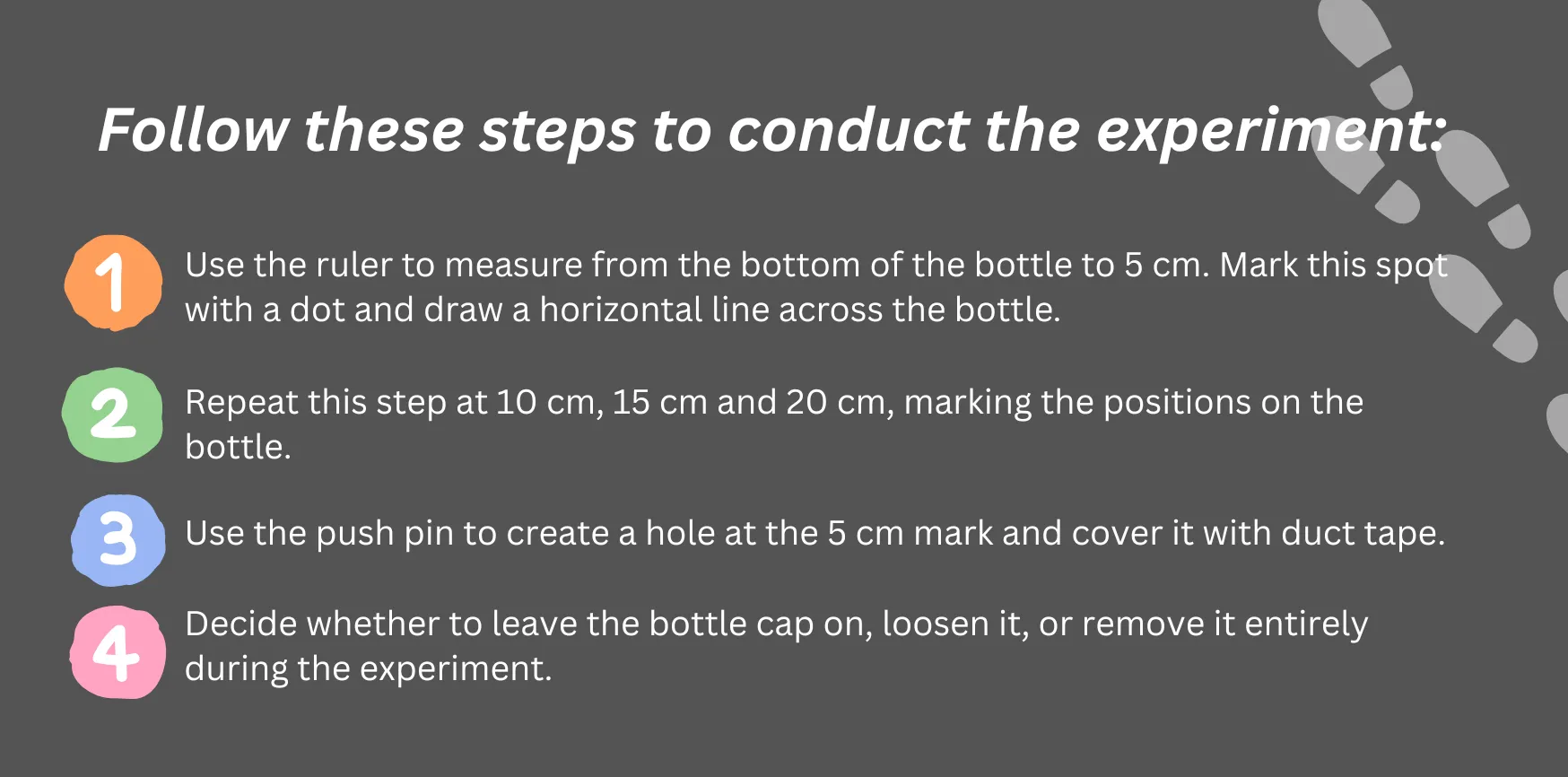
🔧 Procedure
- Fill the soda bottle with water up to the 20 cm mark.
- Place the bottle in a shallow tray or container with the hole pointing downward to catch the water.
- Remove the duct tape from the hole at 5 cm and let the water stream out.
- Measure the distance the water jet projects from the hole and record the result.
- Repeat for 15 cm, 10 cm, and 5 cm water levels, measuring each time.
- Repeat all measurements three times for accuracy.
👉🏻 Record the result in the hydro Worksheet you got from your teacher in Chapter 3.1 – Effect of volume on the force of water – Task 1.
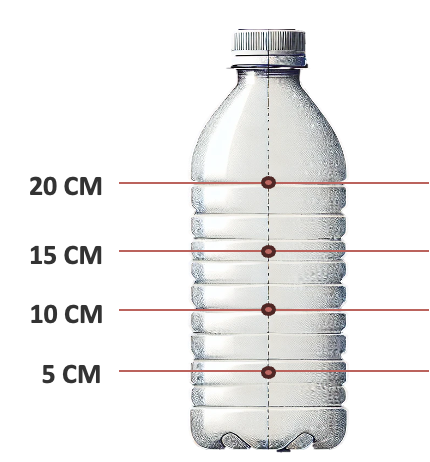
📝 Task 1
- How does the water level affect the distance the jet travels?
- Can you think of real-life situations where this principle applies? List two examples.
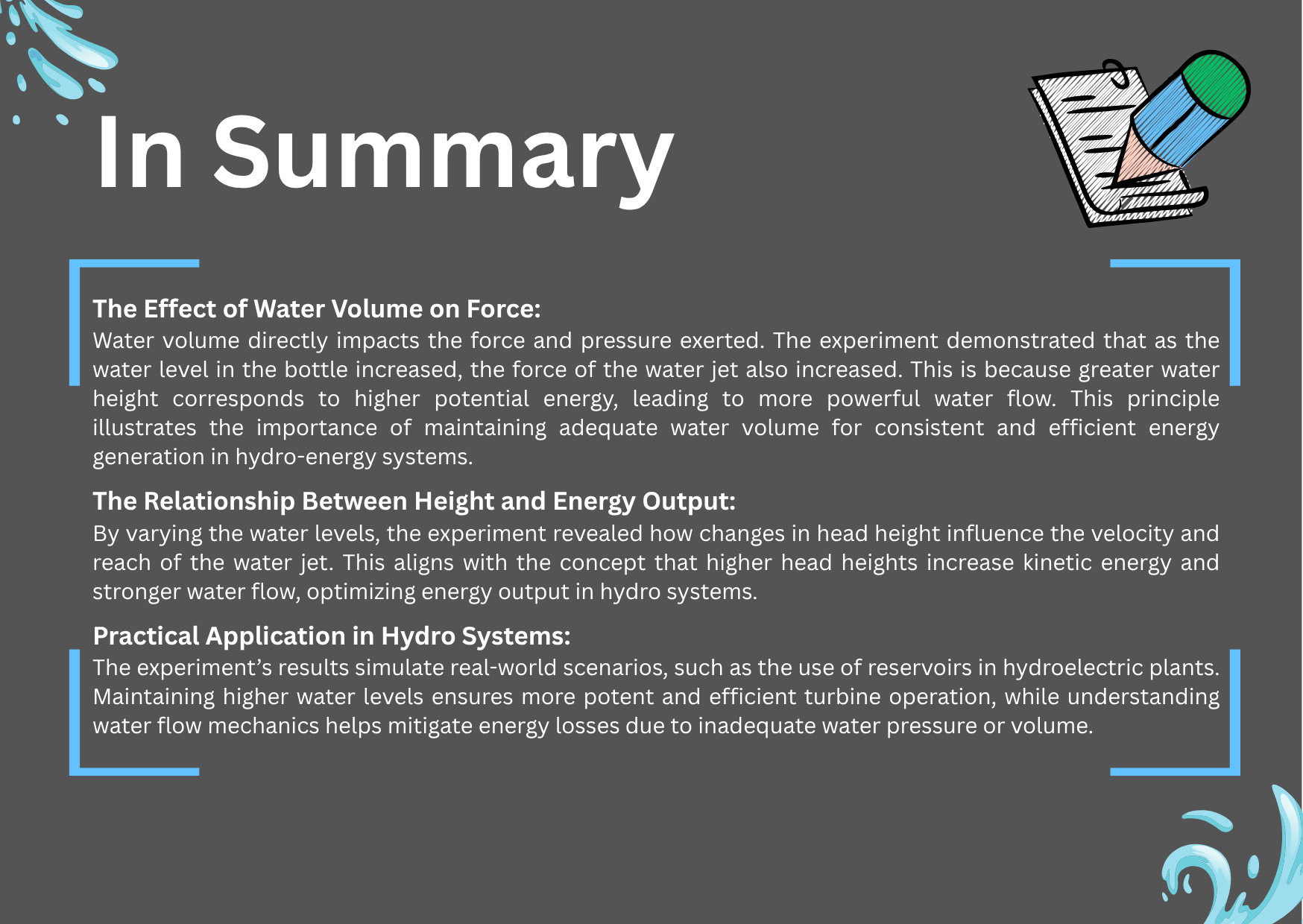
🔧 3.2 – Effect of Obstacles on the Force of Water
Task 1:
This experiment will focus on the water path and how obstacles can disrupt its flow. When an obstacle intervenes, water’s movement changes significantly, affecting both its speed and energy. In this activity, we’ll explore how these disruptions impact the flow.
For this task, imagine you have a pipeline with flowing water. Midway through the pipeline, the flow encounters a significant obstacle made of one of the following materials:
Rank the materials (e.g., sponge, paper, cotton ball, plastic) from 1 to 4 based on how much they block water flow. Explain your reasoning.
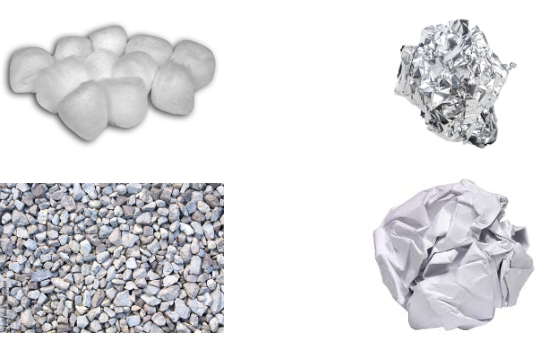
🔬 Experiment
Material you need for this experiment:
- 1 empty 2-liter soda bottle
- 1 ruler
- 1 push pin
- Duct tape
- 1 shallow tray or container
- 3 wide drinking straws
- Permanent marker
- Water supply
- Obstacle materials (cotton, sponge, paper)
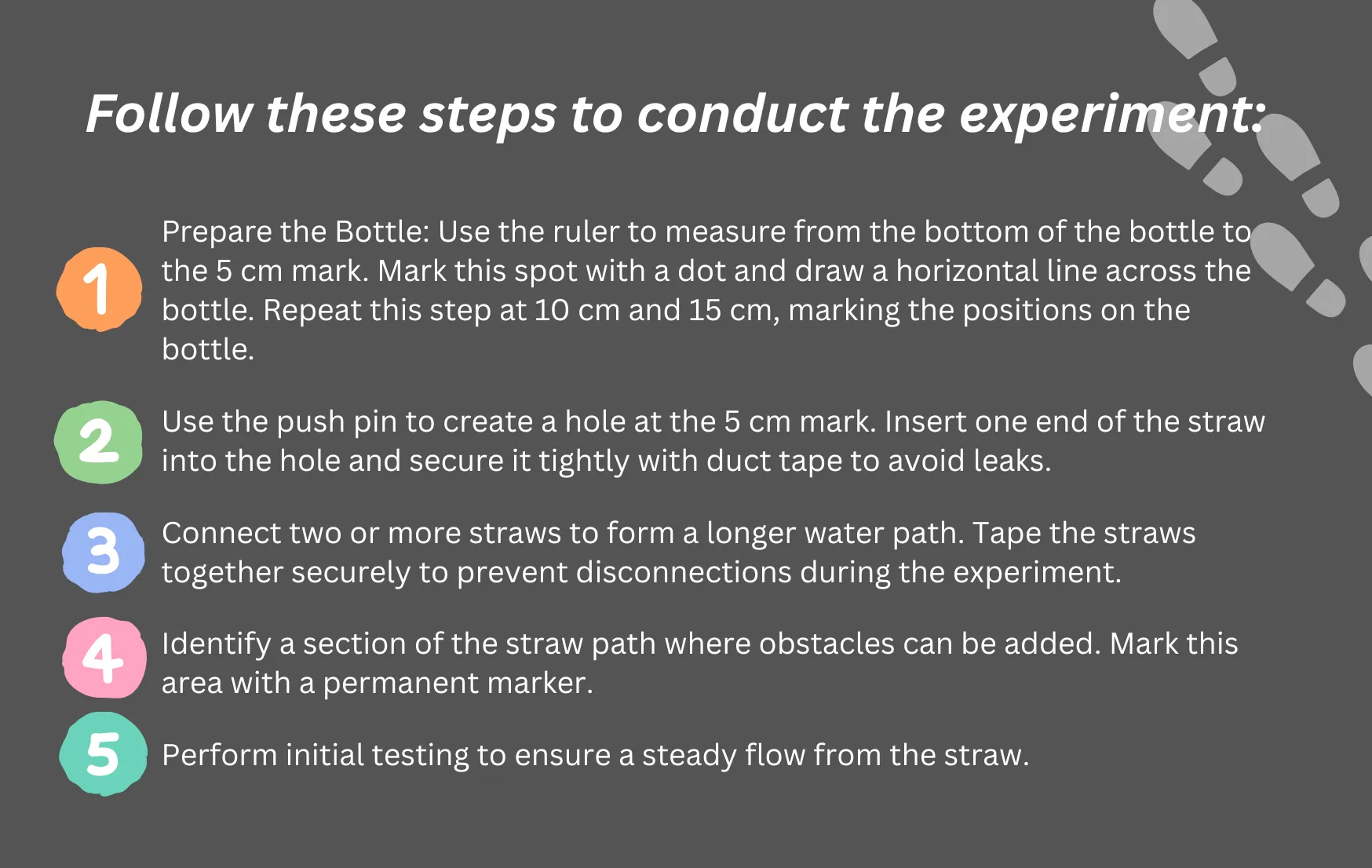
🔧 Procedure
- Fill the soda bottle with water up to the 15 cm mark.
- Place the bottle on a stable surface with the straw directed downward toward the shallow tray or container.
- Let the water flow through the straw without any obstacles. Measure the distance the water path travels and record it.
- Add an obstacle (cotton ball). Measure again.
- Repeat with sponge and paper.
- Repeat for 10 cm and 5 cm water levels.
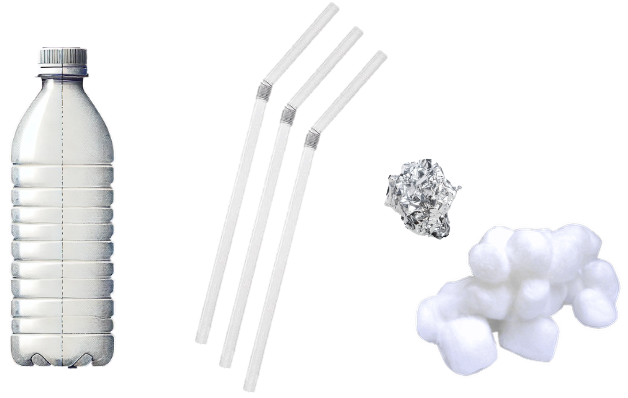
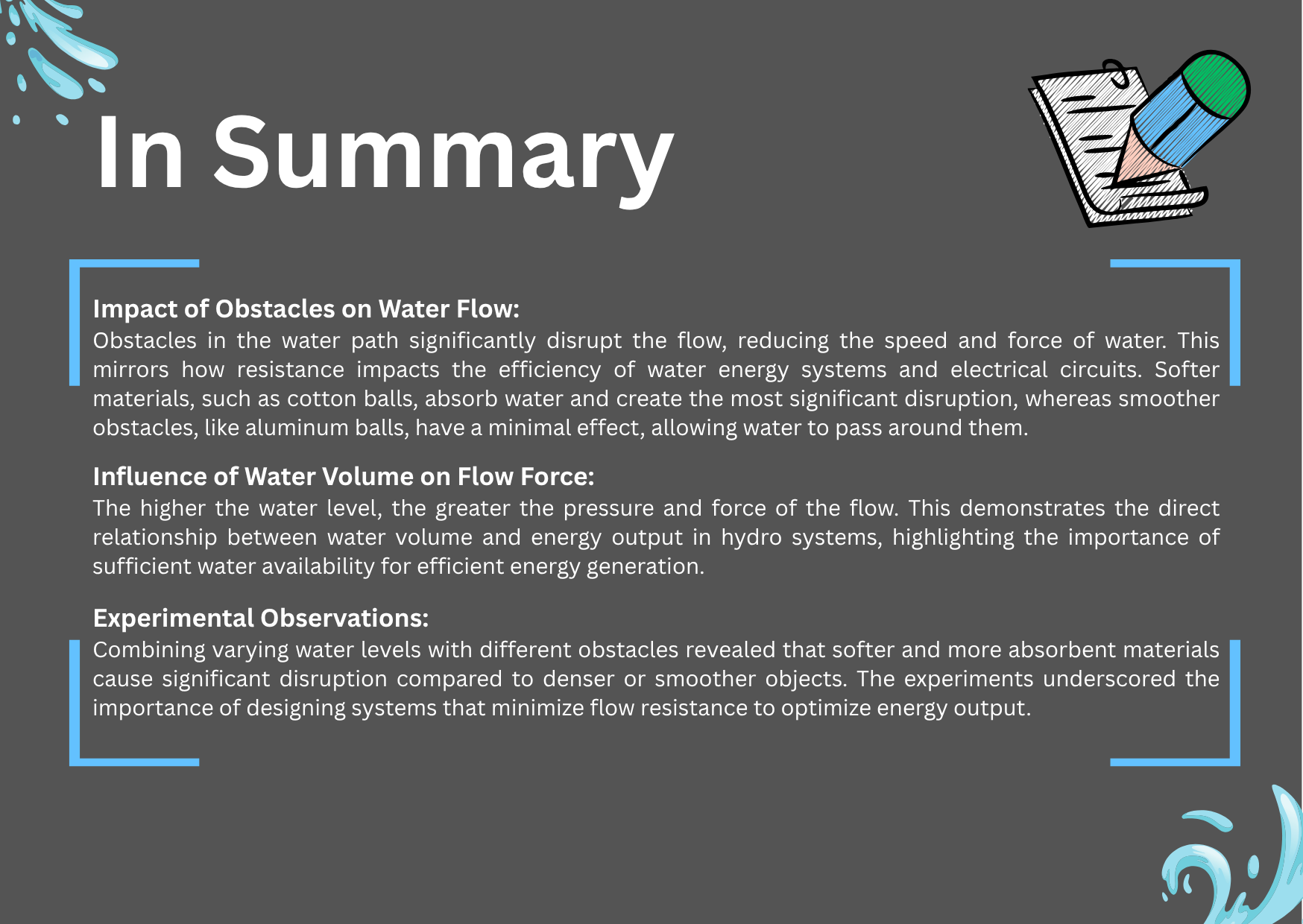
🎯 3.3 – Effect of Head Height on Energy Generation in a Pelton Turbine
🔬 Experiment
Materials you need:
- Pelton turbine (included in the kit)
- Flexible hose to connect the water source to the turbine (included in your kit)
- Measuring tape
- Small generator connected to the Pelton turbine to measure the impact of head height changes (included in your kit, attached to the turbine)
- Water supply
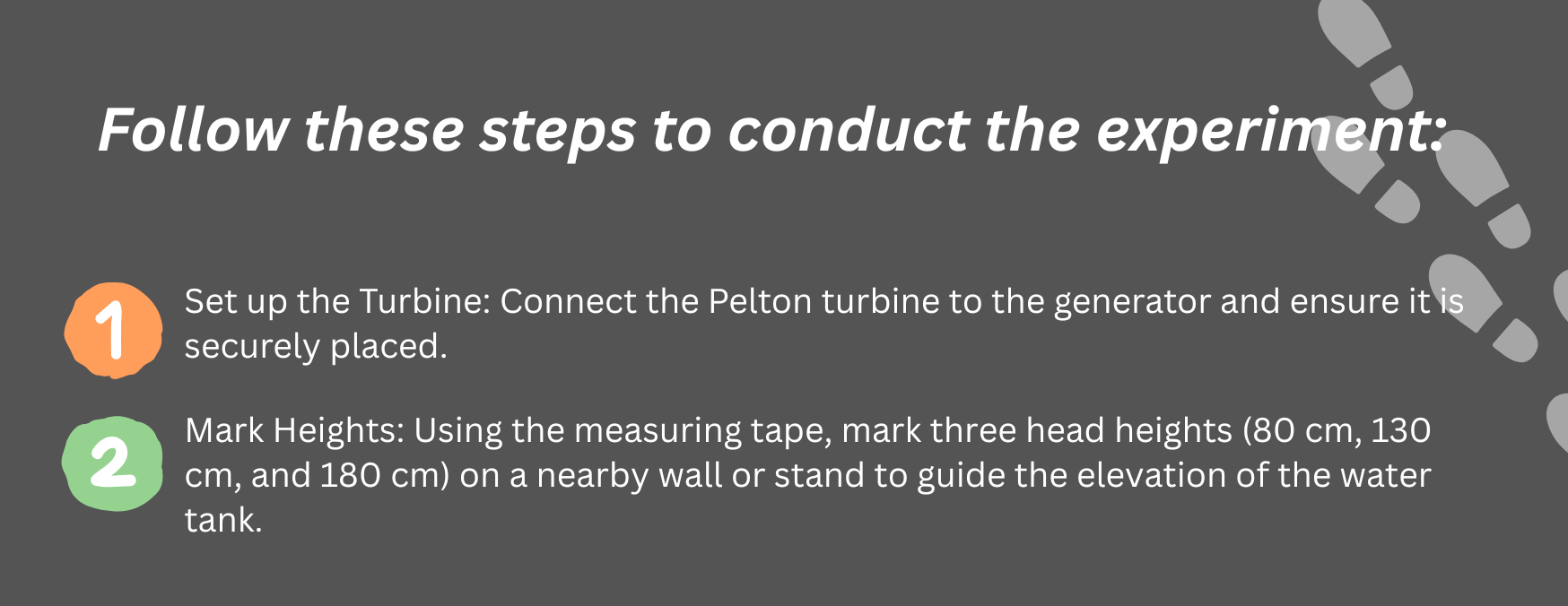
🔧 Procedure
- Fill the water tank or reservoir with water and place it at 80 cm above the turbine.
- Open the valve or allow water to flow through the hose to power the Pelton turbine.
- Using the multimeter, measure the voltage or current generated by the turbine and record the value.
- Repeat the procedure with the tank elevated to 130 cm. Measure and record the voltage or current generated.
- Finally, repeat the procedure with the tank elevated to 180 cm, recording the corresponding voltage or current generated.
- Perform at least two trials for each height to ensure accuracy.
📝 Exercise
Task:
- How did height affect the energy output?
- Why does higher head height increase power?
- How could this be applied in real-world hydro plants?
📌 In Summary
Objective: This experiment aimed to explore how variations in head height influence energy output in a Pelton turbine. By adjusting water height, you observed changes in water pressure, turbine speed, and energy generation, providing insights into real-world applications of hydropower systems.
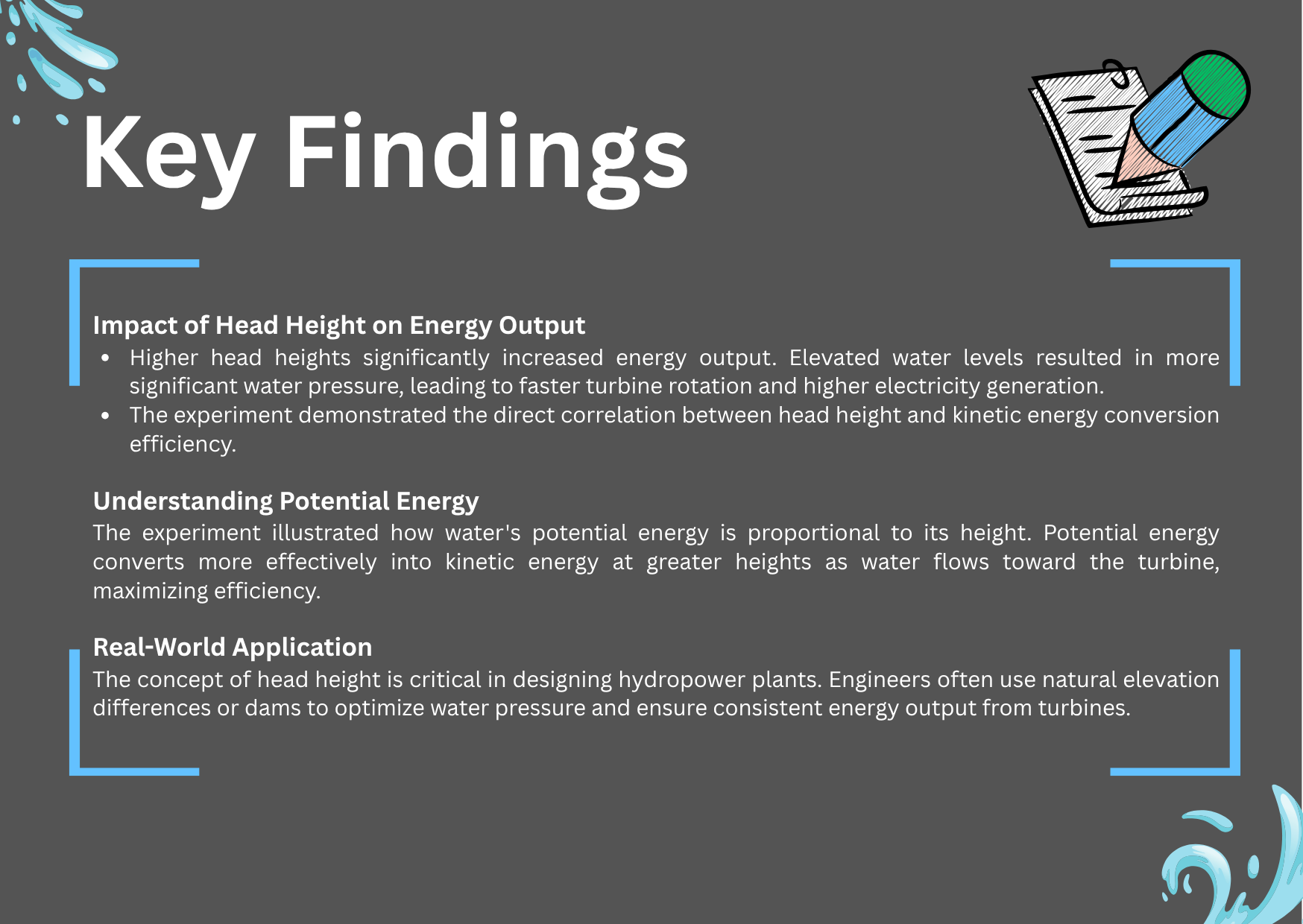
💡 Practical Skills Developed:
- Kit Assembly: You learned how to assemble the hydro energy kit, including attaching the turbine to the case, connecting the generator and ensuring all components were securely fastened.
- Instrument Usage: The experiment provided practical training in using a multimeter to measure voltage and current.
- Data Collection and Analysis: You were able to record and analyze energy output at different heights, enhancing their ability to interpret experimental results.
🔌 Chapter 4 – Concepts of Grid and Combining DERs
⚡ 4.1 – Baseload and Reliability of PV, Wind and Hydro Energy
This bingo game offers a playful yet essential way to understand the varying reliabilities of renewable energy sources like PV, wind, and hydro—especially in the context of baseload and its critical role in grid stability.
Exercise
Task 1:
- In the worksheet you received from your teacher in Chapter 4, you’ll find a table with 16 answers, each corresponding to one of 16 questions in a Question Bank.
- Your teacher will randomly select and read one question aloud from the Question Bank.
- Your task is to match that question with the correct answer from your sheet.
- If you correctly match 4 in a row (horizontally, vertically, or diagonally), you score a BINGO! 🥳
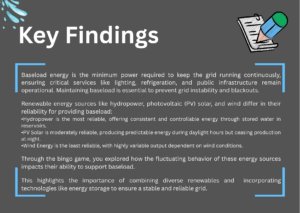
⚖️ 4.2 – Energy Balancing Game
Understand the causes and effects of fluctuating renewable electricity generation when it meets varying energy demand. Explore how these fluctuations impact the energy grid, including issues like surpluses and deficits. Gain hands-on experience in identifying strategies to achieve and maintain a perfect balance within the system, ensuring grid stability and efficiency.
🧩 Exercise
On the next page, you will find an Energy Demand Sheet detailing the electricity requirements for a city over five working days (Monday to Friday). The city generates electricity using a PV & Wind park, and a hydropower plant. At the bottom of the sheet, you will see whether there is a surplus or deficit in energy during the morning, midday, or evening for each day. Your task is to guide the city through various scenarios that arise during the week, including sunny, windy, and high-demand situations.
- Carefully analyze the energy demand and generation data provided.
- Work through Tasks 1 to 4, using the information to solve the challenges presented for each day.
- Apply your understanding of energy balancing to ensure the city maintains a stable and reliable electricity grid.

📅 Task 1: Monday – Explore electricity generation and demand
- What can you tell about the electricity generation of PV, wind, and hydro?
- Rank the reliability of the three renewable energy sources from highest to lowest.
- What is surplus/deficit energy, and how is it calculated? Why is it important?
- What would you consider baseload and peakload on Monday?
📅 Task 2: Tuesday
- Calculate the surplus/deficit energy during the evening (16:00–24:00).
- How would you handle a deficit in the energy grid? What could you do in this situation to avoid a blackout?
📅 Task 3: Wednesday
- What happens to the demand during the street festival in town?
- How does the surplus/deficit look during this period?
- How can you handle this deficit without producing more energy or using storage?
📅 Task 4: Thursday & Friday
- Calculate the deficits/surpluses for each period on Thursday and Friday.
- Why is the city experiencing such large surpluses and deficits on these two days?
- What should the city do to balance electricity generation and demand for Thursday and Friday?
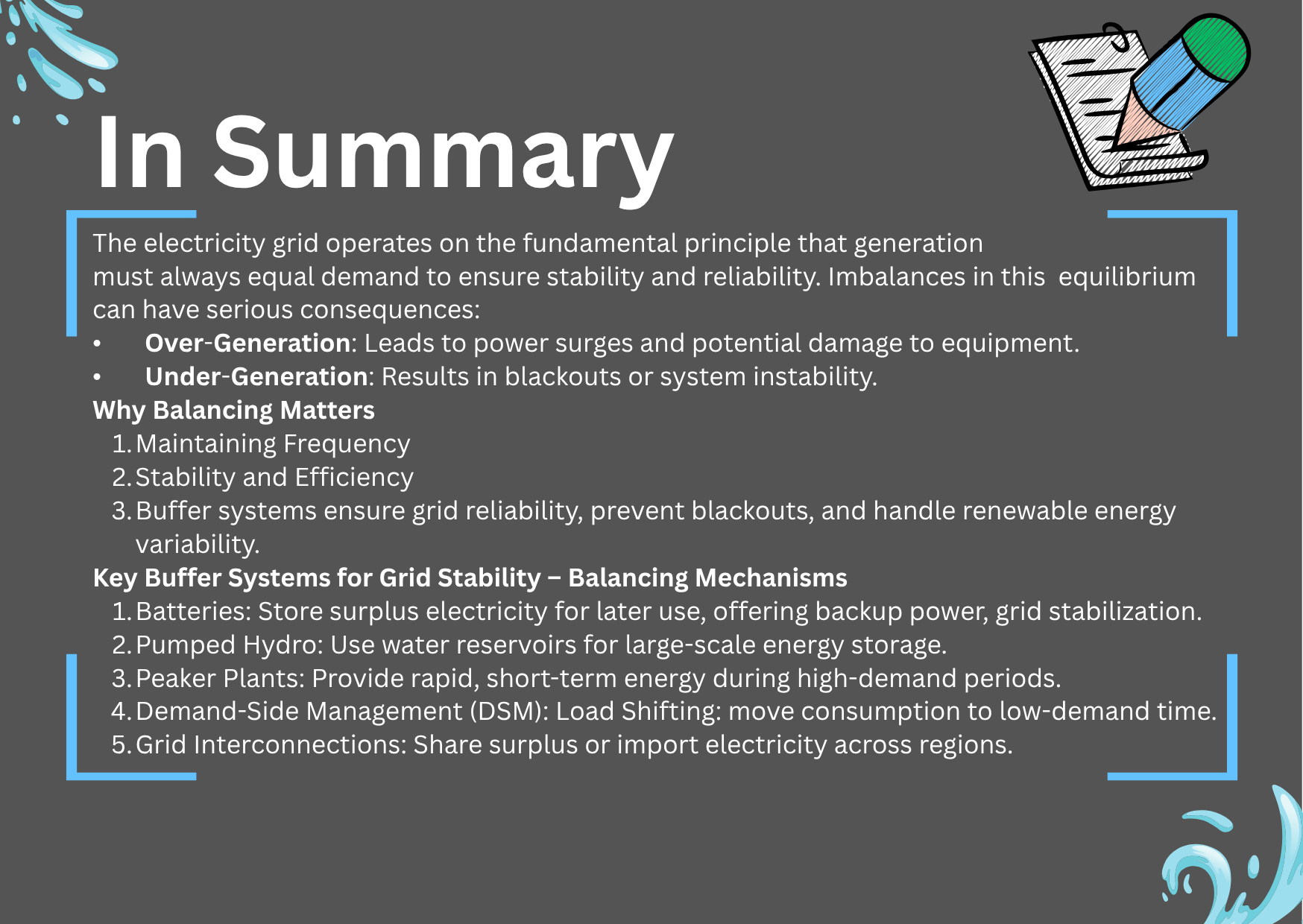
🔌 4.3 – Design and Energy Grid Game
Now you will design and operate a simulated power grid, making decisions about energy generation, storage, and connectivity to meet the demand of a central grid while dealing with variability in energy sources.
🎯 Exercise
Material you need for this experiment:
- Grid template (provided in the workbook)
- Markers or pens
- Notebook
- One six-sided dice per energy zone (or virtual dice at dice.virtuworld.net)
- Battery tracker (drawn in notebooks, max capacity: 10 energy units)
- Demand tracker sheet (provided in the workbook)
You are given a blank grid template in Chapter 4 in your Worksheet with three energy zones (Solar, Wind, Hydro) and one central demand zone.
- Draw connections between the energy zones and the central demand zone.
- Decide whether to connect a battery storage and where to place it.
Each connection will cost one energy token per round.
🎲 Gameplay Rules
📓 Set Up the Notebook:
- Create a table to track:
- Energy generated by each source (Solar, Wind, Hydro)
- Energy stored/retrieved from the battery
- Energy sent to the central grid
- Total energy vs. demand per round
- Draw a battery tracker (max capacity: 10 units)
🎲 Roll the Dice for Generation:
| Solar | Output | Wind | Output | Hydro | Output |
|---|---|---|---|---|---|
| 1 | 2 units | 1 | 1 unit | 1 | 5 units |
| 2 | 3 units | 2 | 2 units | 2 | 6 units |
| 3 | 4 units | 3 | 4 units | 3 | 7 units |
| 4 | 5 units | 4 | 6 units | 4 | 8 units |
| 5 | 6 units | 5 | 7 units | 5 | 9 units |
| 6 | 8 units | 6 | 9 units | 6 | 10 units |
Record the results of the dice rolls in your notebook under “Energy Generated.”
🔌 Decide on Connections:
- Choose which energy zones send power to the central grid or battery.
- Each connection costs 1 unit per round (subtract in your log).
🔋 Store & Retrieve Energy:
- Excess energy goes into the battery (max 10 units).
- Retrieve stored energy to cover deficits when needed.
- Lose 1 unit to dissipation each round from stored battery energy.
⚖️ Meet the Demand:
Calculate the energy sent to the grid from connected zones and the battery (if used).
Compare the total energy sent to the demand level:
- Round 1 Demand: 10 units.
- Round 2 Demand: 15 units.
- Round 3 Demand: 20 units.
Record the outcomes in the notebook:
- Shortfall: Available energy is less than demand.
- Excess: Available energy exceeds demand (recorded as wasted energy).
🏆 Scoring:
- Reliability: 2 points for each round where demand is fully met.
- Efficiency: 1 point for minimizing wasted energy (1 point for each round with zero excess energy).
- Strategy: 1 bonus point for practical battery usage (e.g., no overflows or under-utilization).
💬 Discussion:
- How did variability in energy generation (dice rolls) impact your ability to meet demand?
- How did your choice to use (or not) the battery affect your grid’s reliability?
- If you redesigned the grid, how would you improve reliability and efficiency?
- What lessons can you apply from this activity to real-world energy systems?
